Slow start this morning, because of course with the transit home looming ahead of us tomorrow I am starting to feel like I have a head cold. Boo-hiss! There’s no good time to get crook when you’re travelling, but right before being in transit for 40 hrs or more, totally isn’t it.
Yesterday was supposed to be 5°C (with a, ‘feels like 0°-1°C with the windchill factor), and I was not ready for it at all. Went out with insufficient layers (never fear, fixed it with a credit card), and then today, I was like totally ready for it and went out with all the clothing and extras in my bag, only to find it had increased stupidly in temperature overnight to a balmy 17°-19°C and I found myself completely overdressed and looking for a bathroom to rip off my merino layer asap. Can’t win.
We headed out to Charlottenburg Palace today via a quick stop through Checkpoint Charlie to get to our train. Slightly fewer tourists here today than Sunday but still the badly garbed actors and the ever present American capitalist icon, McDonald’s. 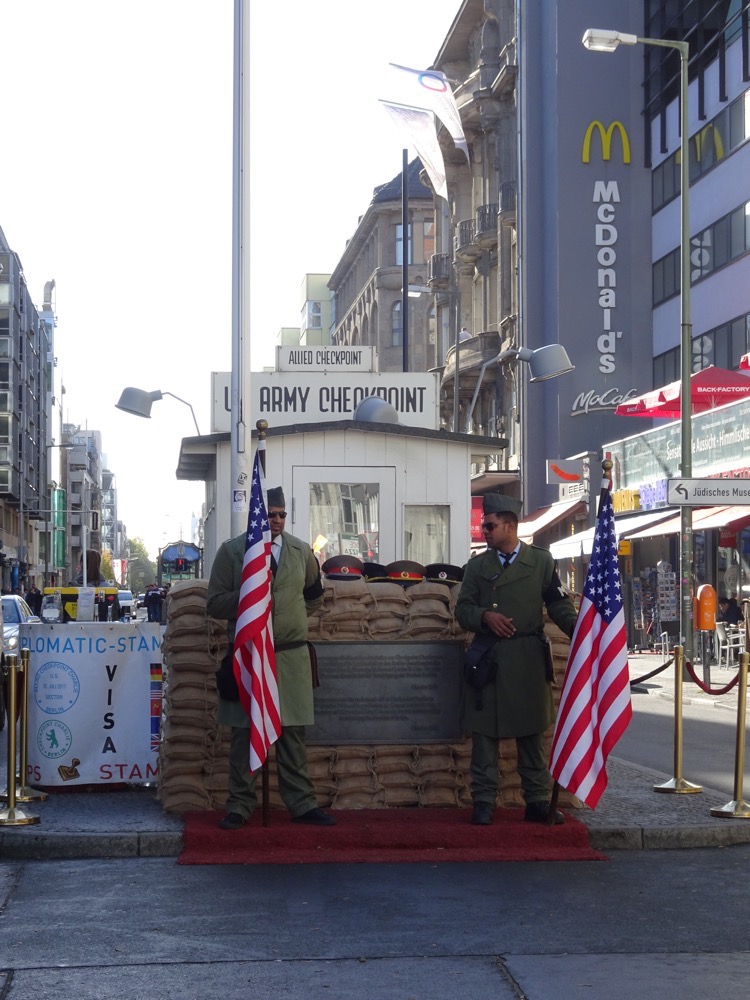
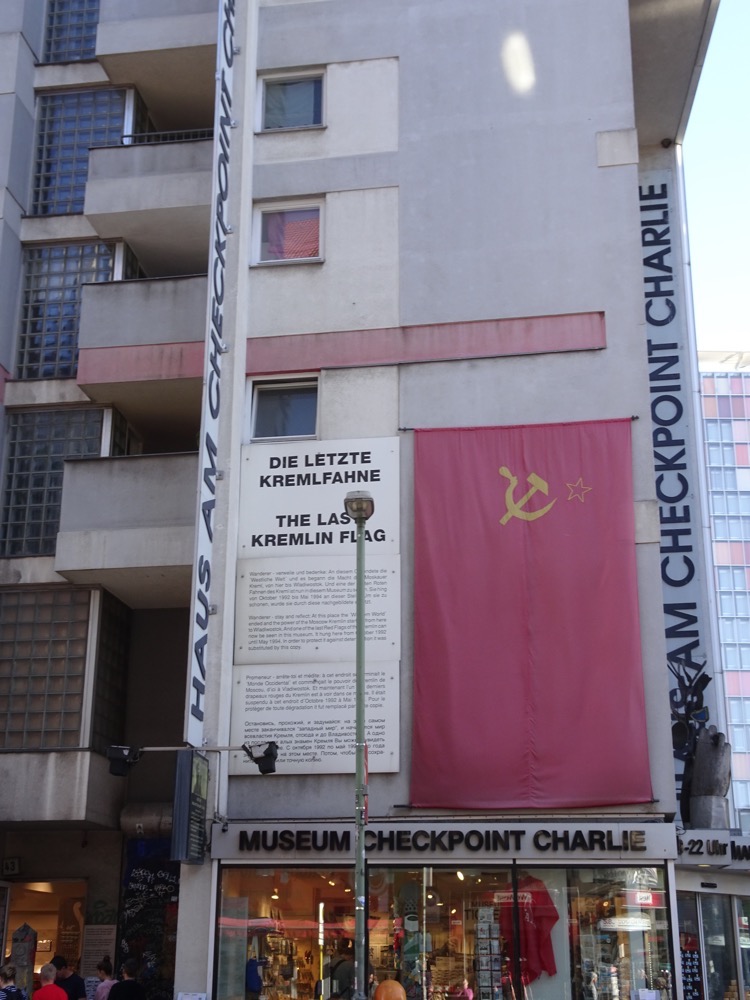 Train stations in Berlin are nowhere near as deep as London, New York or Kyiv and definitely not as pretty as Moscow or St Petersburg – but some of them make a striking statement. At the Checkpoint Charlie end:
Train stations in Berlin are nowhere near as deep as London, New York or Kyiv and definitely not as pretty as Moscow or St Petersburg – but some of them make a striking statement. At the Checkpoint Charlie end: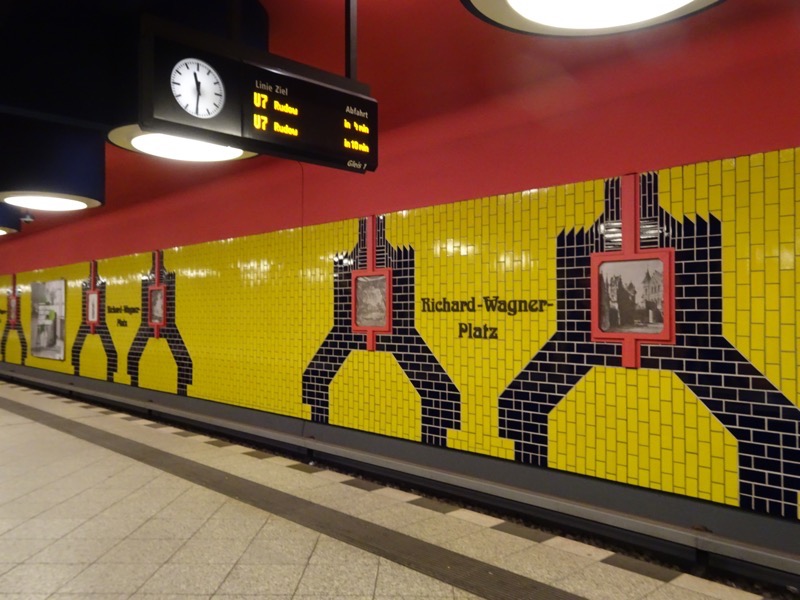 And copies of golden mosaics representing historical rulers of Saxony, Prussia and who knows where else, at the other end.
And copies of golden mosaics representing historical rulers of Saxony, Prussia and who knows where else, at the other end.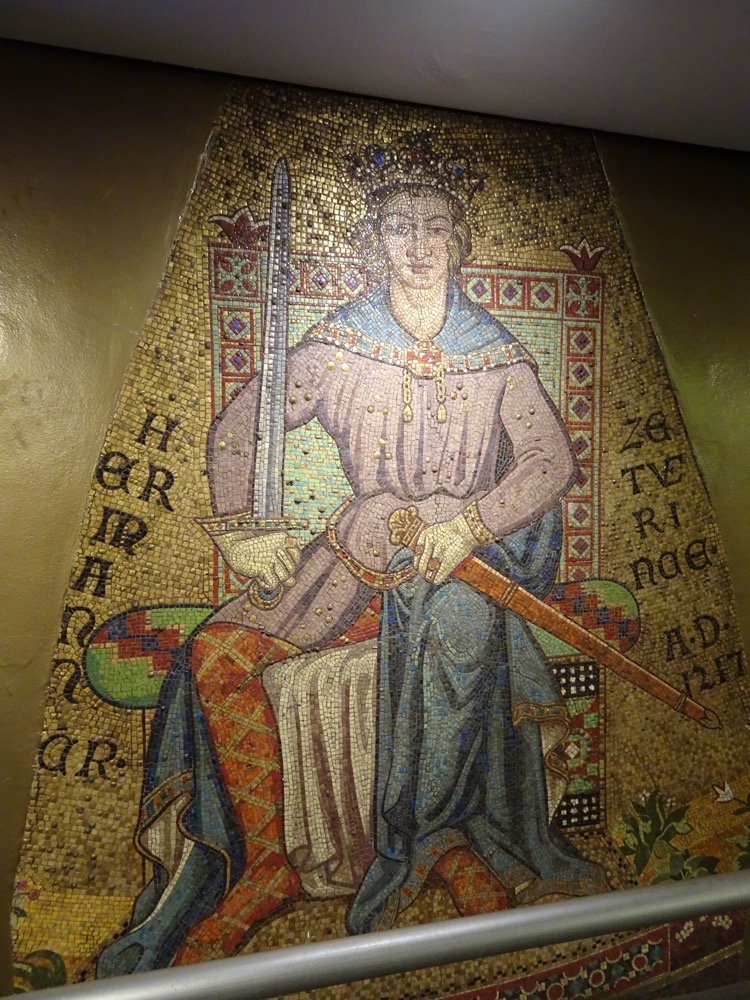
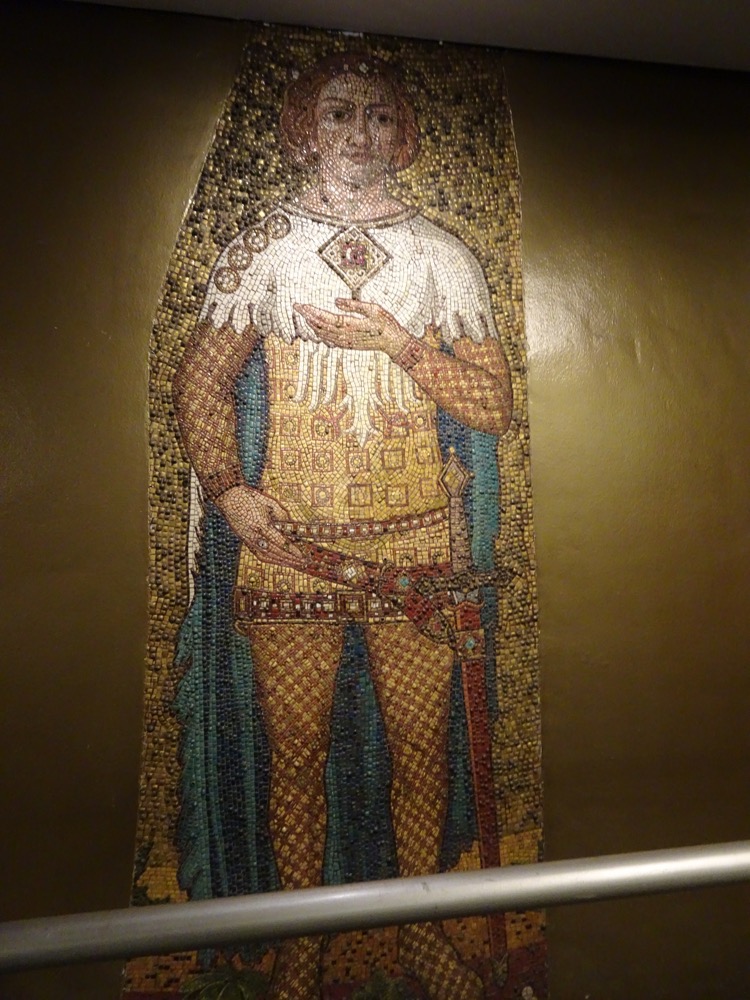 I haven’t managed to photograph many Berlin Bears – whenever we see them, there are usually annoying tourist standing with them for ten minutes or more trying to get that elusive perfect selfie, so we have mostly just passed by them.
I haven’t managed to photograph many Berlin Bears – whenever we see them, there are usually annoying tourist standing with them for ten minutes or more trying to get that elusive perfect selfie, so we have mostly just passed by them.
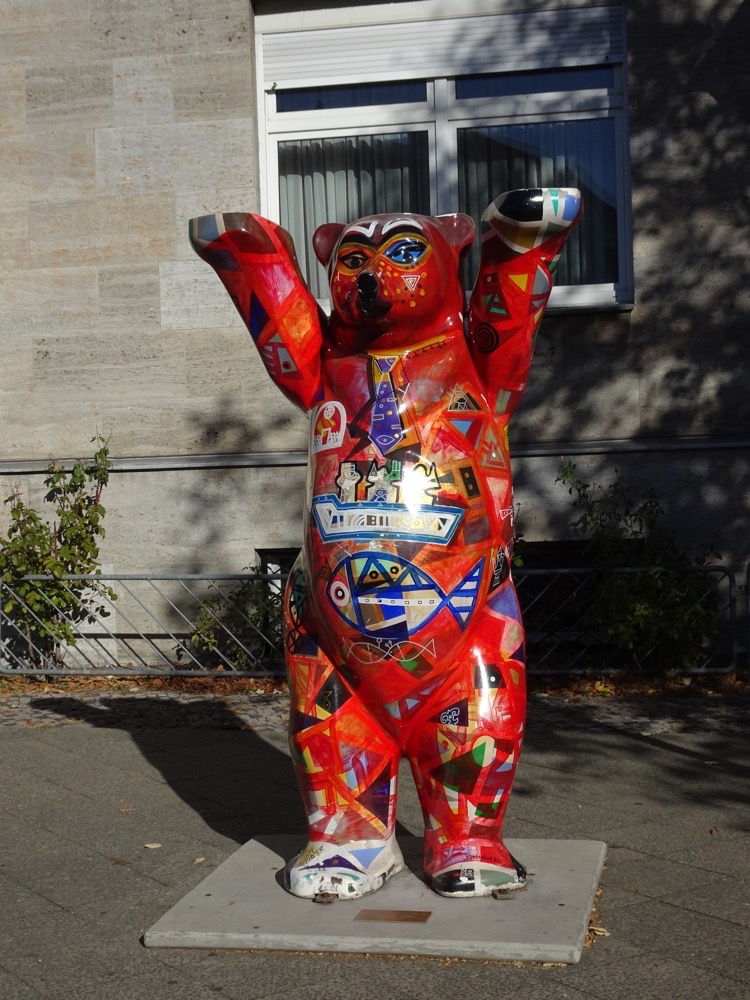 Charlottenburg Palace was originally built at the end of the 17th century, and then expanded upon enormously following century. It is done in extravagant baroque and rococo styles as of course was fitting for the woman who commissioned it, Sophie Charlotte, the wife of Friedrich I who was Elector of Brandenburg at the time.
Charlottenburg Palace was originally built at the end of the 17th century, and then expanded upon enormously following century. It is done in extravagant baroque and rococo styles as of course was fitting for the woman who commissioned it, Sophie Charlotte, the wife of Friedrich I who was Elector of Brandenburg at the time.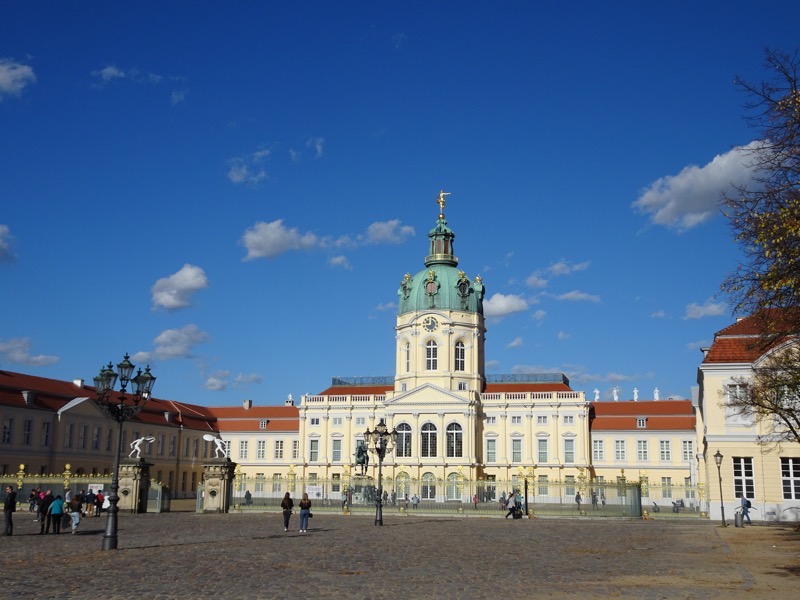 Friedrich crowned himself as King Friedrich I in Prussia in 1701 having two years earlier appointed Johann Friedrich von Eosander to be his royal architect on the extension project. Von Eosander spent a great deal of time in Italy and France studying places like Versailles, and I think that influence is fairly evident. When the royal architect returned in 1702 he put into place his plans to extend the palace to have two large wings and a courtyard in the front, and to also extend the entire length of the main building as well. Poor Sophie Charlotte died in 1705, long before it was finished and Friedrich named the palace, ‘Charlottenburg’ in her memory. Mind you, that’s him up there on that horse right out front of the place… not her.
Friedrich crowned himself as King Friedrich I in Prussia in 1701 having two years earlier appointed Johann Friedrich von Eosander to be his royal architect on the extension project. Von Eosander spent a great deal of time in Italy and France studying places like Versailles, and I think that influence is fairly evident. When the royal architect returned in 1702 he put into place his plans to extend the palace to have two large wings and a courtyard in the front, and to also extend the entire length of the main building as well. Poor Sophie Charlotte died in 1705, long before it was finished and Friedrich named the palace, ‘Charlottenburg’ in her memory. Mind you, that’s him up there on that horse right out front of the place… not her.
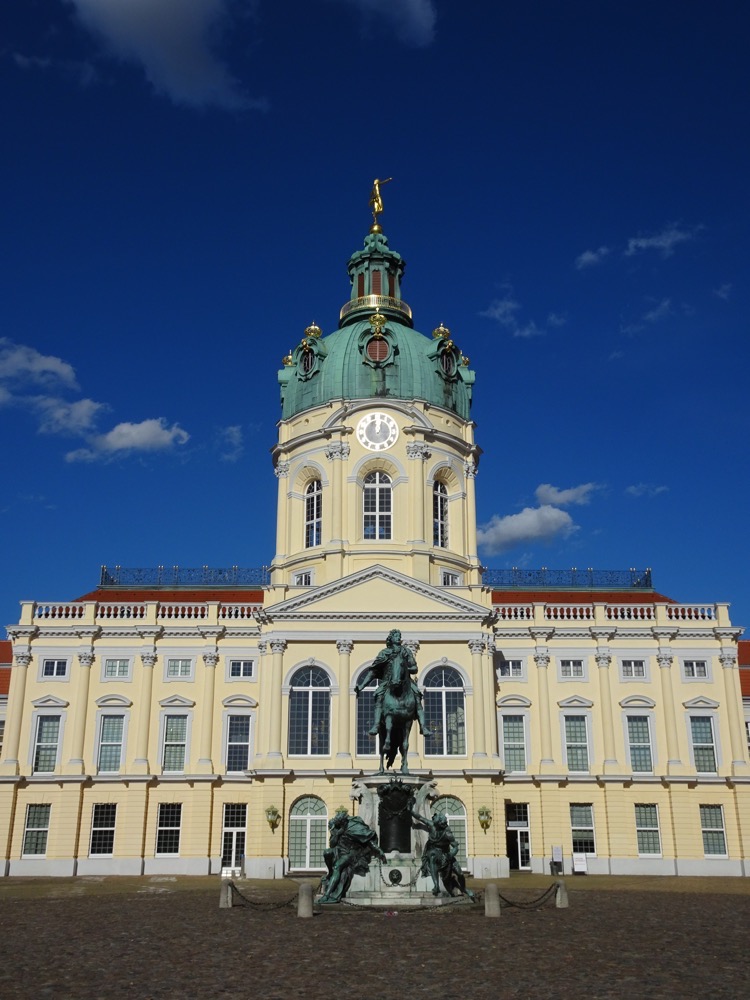 The Orangerie off to the left side of the palace.
The Orangerie off to the left side of the palace.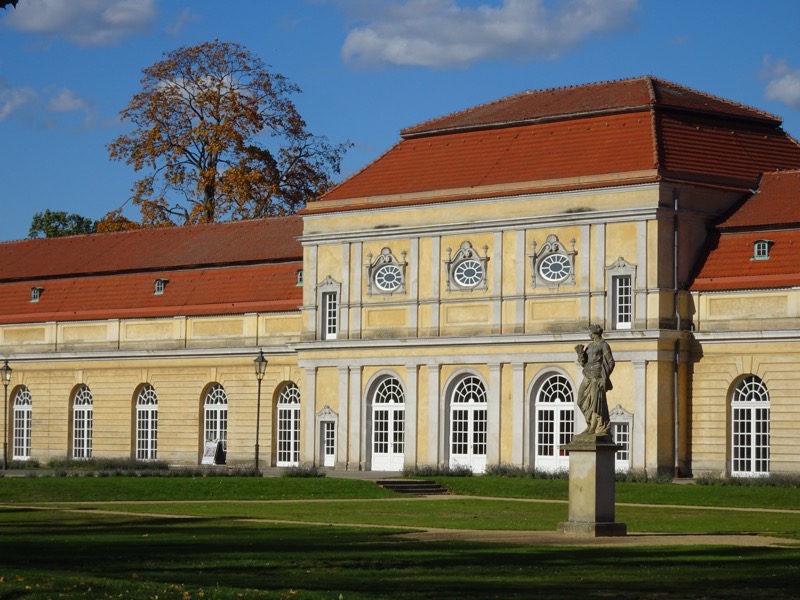 The dressing room to the ‘Mecklenburg Apartment’ which comprises of three rooms that were used to receive relatives from the House of Mecklenburg. The relief images above the doors are all original as are the parquetry floors, the fireplace and wooden panelling.
The dressing room to the ‘Mecklenburg Apartment’ which comprises of three rooms that were used to receive relatives from the House of Mecklenburg. The relief images above the doors are all original as are the parquetry floors, the fireplace and wooden panelling.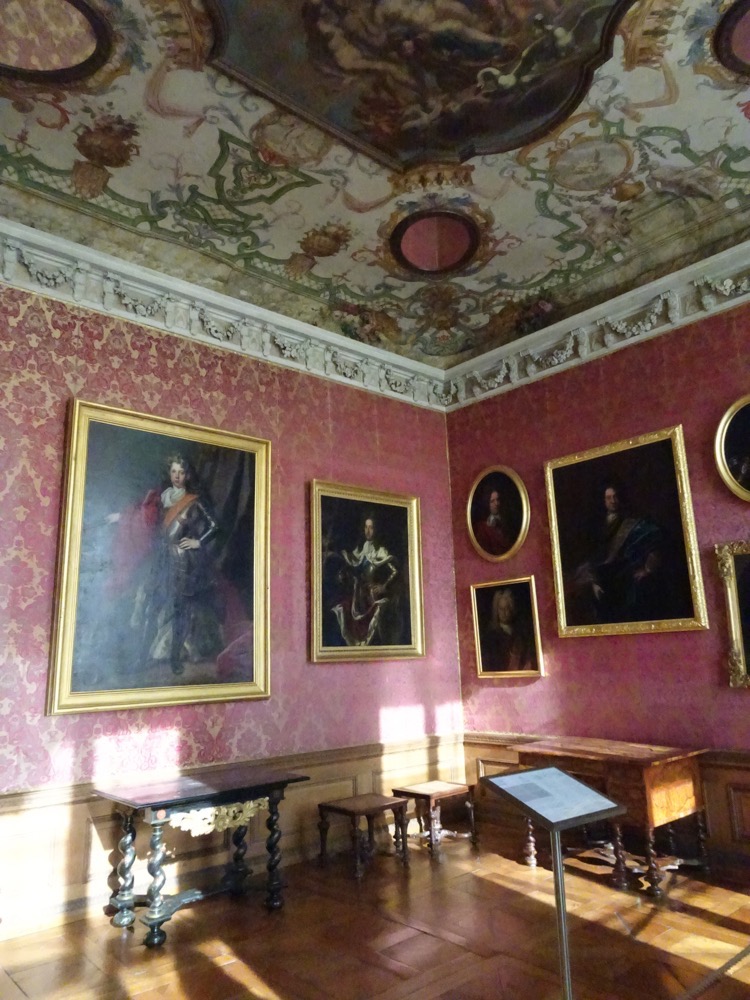
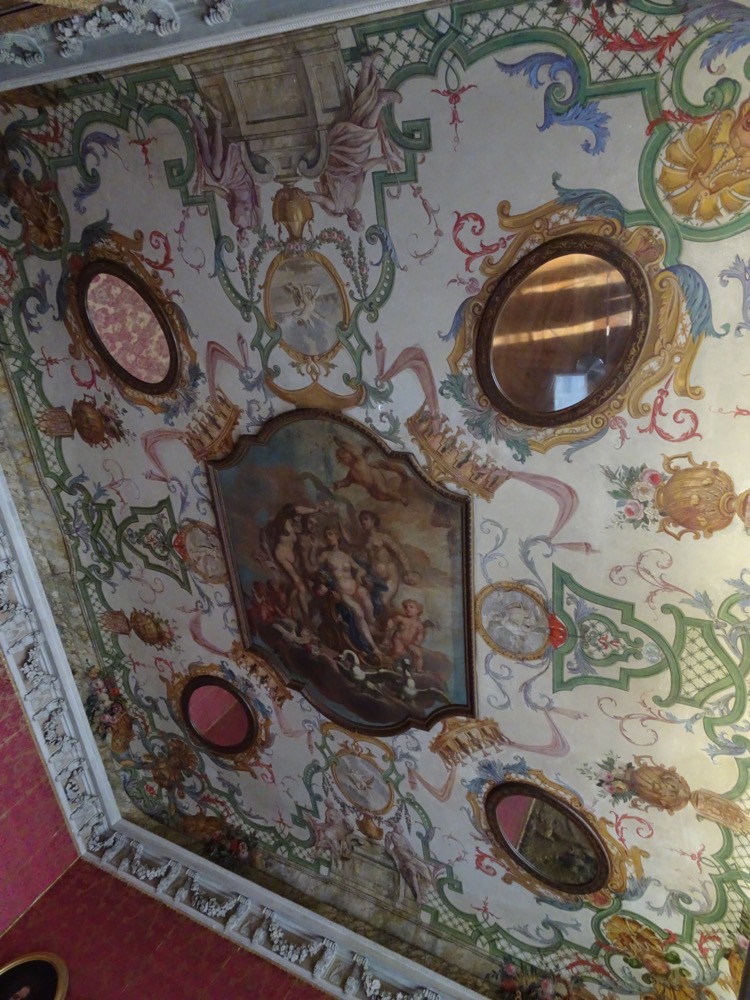
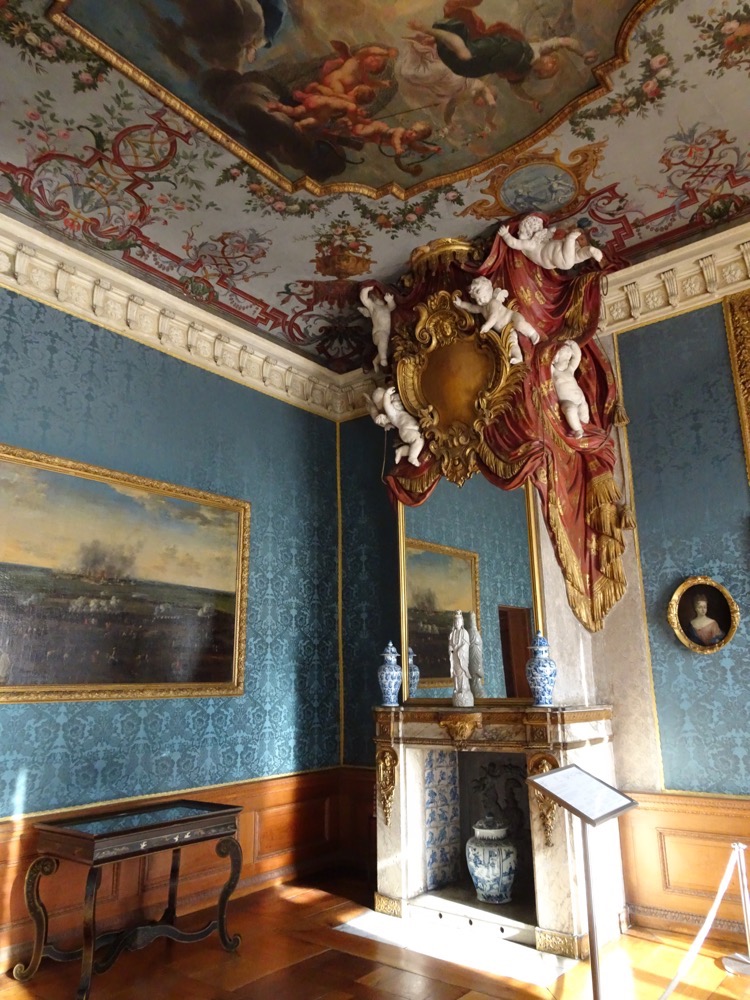
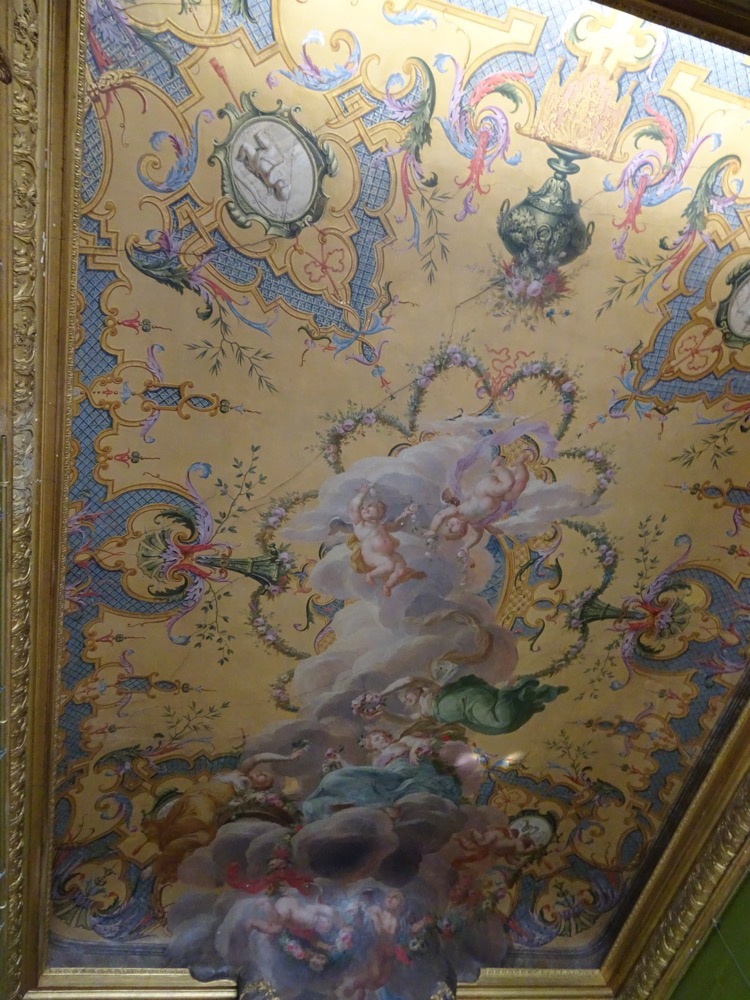
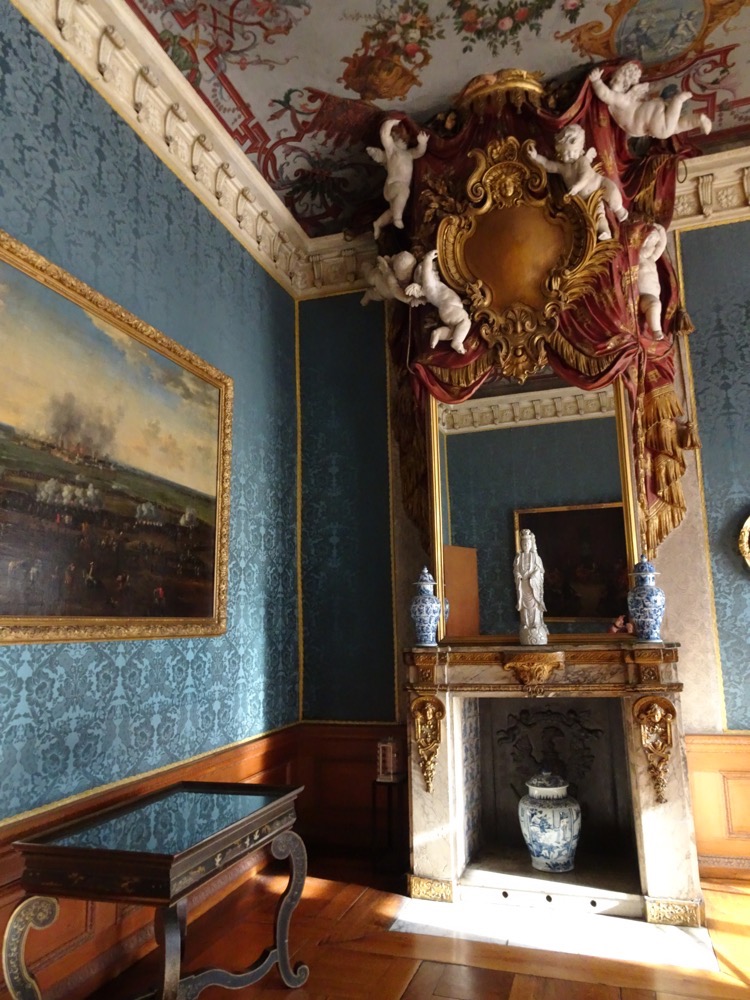 The Old Gallery – this was damaged considerably in 1943, so the oak panelling and the paintings are all copies.
The Old Gallery – this was damaged considerably in 1943, so the oak panelling and the paintings are all copies. 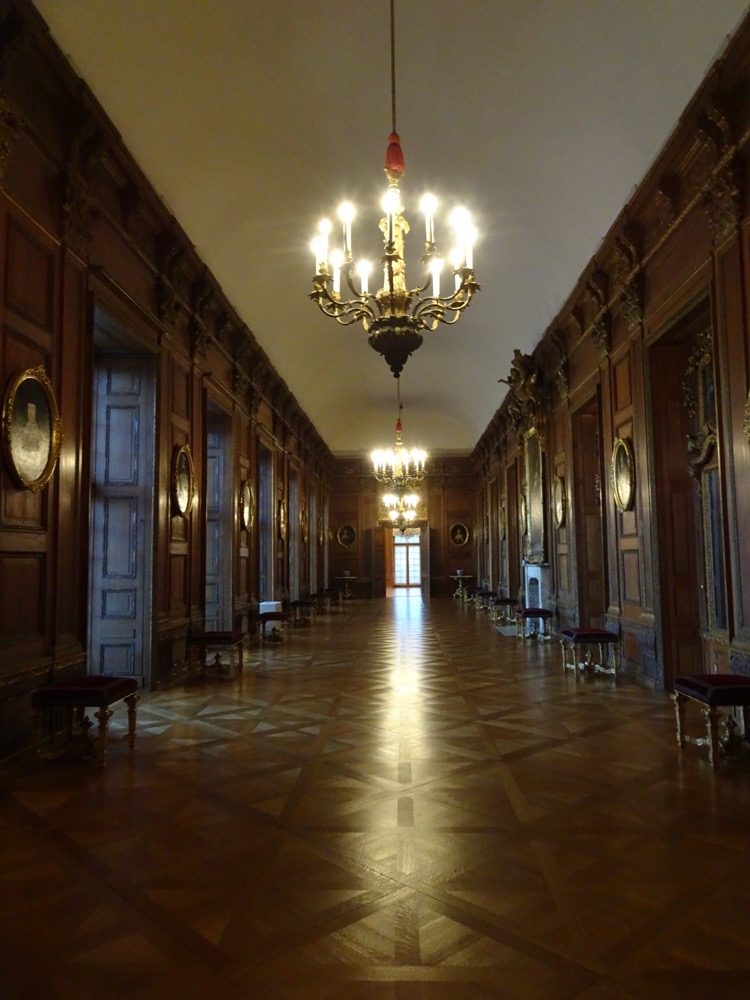 There is a pair of these candlesticks, but they are in vitrines so far apart that it’s nearly impossible to photograph the pair together. They were made for King Frederick William I from the Silver Buffet at the Berlin Palace. The candlesticks were entirely cast in solid silver and are the last items remaining of the Prussian royal palaces’ silver setting. Friedrich apparently placed extensive commissions with the south German master goldsmiths of Auber (more than any other German Prince) and his orders for just three years from 1730 to 1733 included 85 silver objects with a total weight of over 8 tonnes. Only six works have survived including these two (of ten) candlesticks. All the other works were melted down in the mid 1700s and early 1800s. They’re enormous – all monograms and Prussian eagles.
There is a pair of these candlesticks, but they are in vitrines so far apart that it’s nearly impossible to photograph the pair together. They were made for King Frederick William I from the Silver Buffet at the Berlin Palace. The candlesticks were entirely cast in solid silver and are the last items remaining of the Prussian royal palaces’ silver setting. Friedrich apparently placed extensive commissions with the south German master goldsmiths of Auber (more than any other German Prince) and his orders for just three years from 1730 to 1733 included 85 silver objects with a total weight of over 8 tonnes. Only six works have survived including these two (of ten) candlesticks. All the other works were melted down in the mid 1700s and early 1800s. They’re enormous – all monograms and Prussian eagles.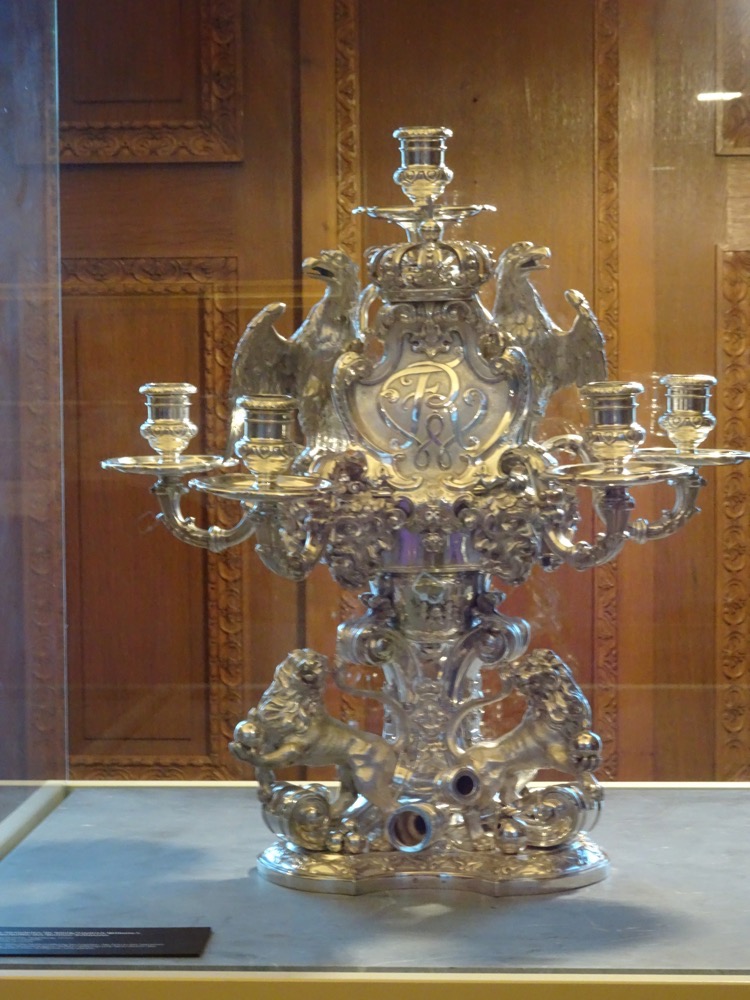
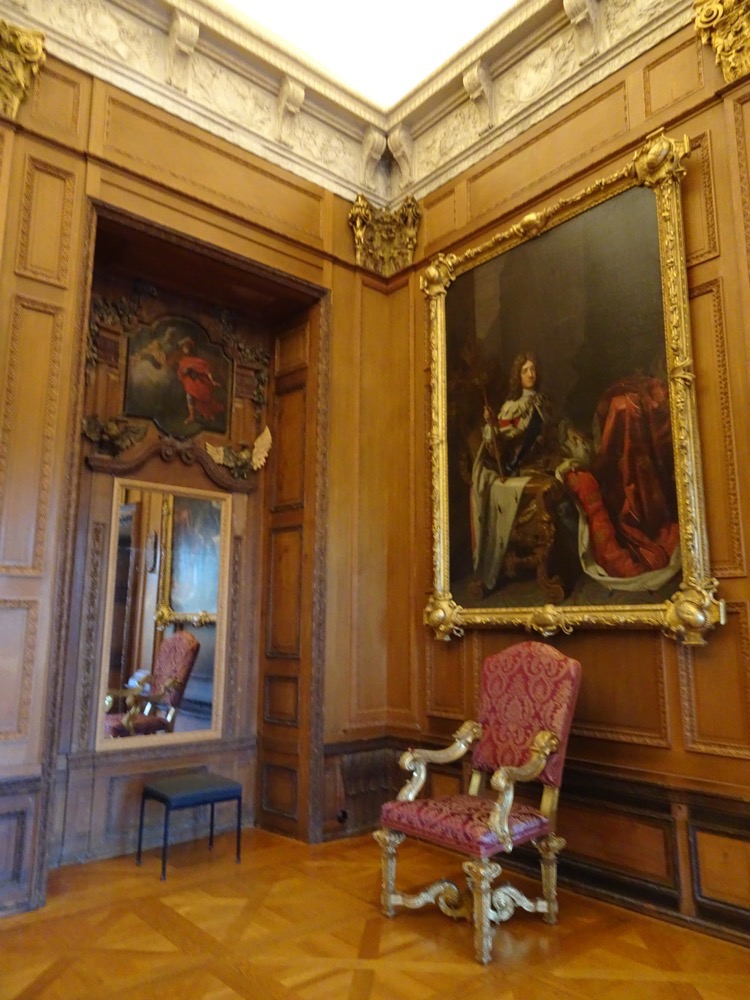 The aptly named, Mirror Panelled Bed Chamber was part of Sophie’s original five room apartments. The mirrors were to reflect the lavish gardens outside.
The aptly named, Mirror Panelled Bed Chamber was part of Sophie’s original five room apartments. The mirrors were to reflect the lavish gardens outside.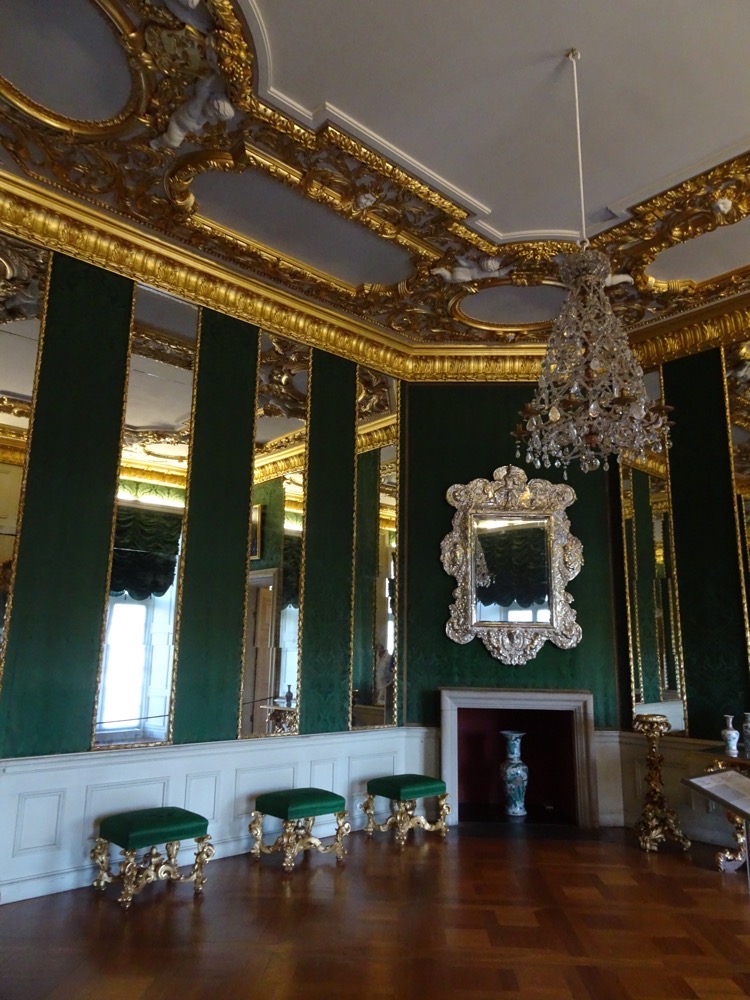 This section of the Palace too, was badly damanged in WWII and has been recreated to be a fair approximation of what was here earlier.
This section of the Palace too, was badly damanged in WWII and has been recreated to be a fair approximation of what was here earlier.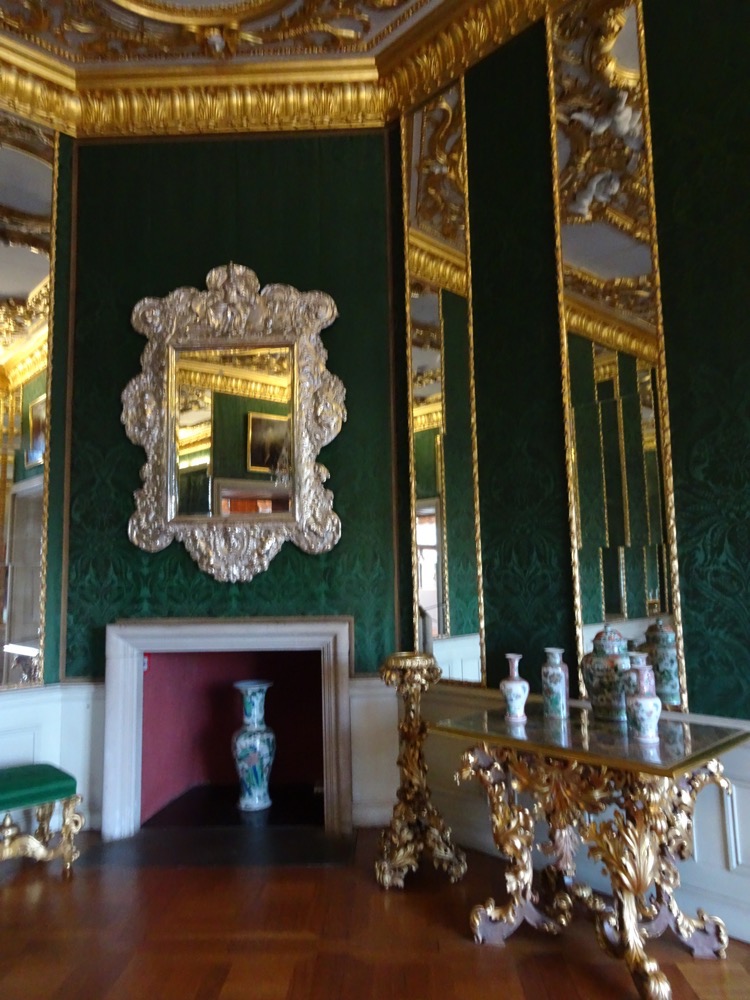
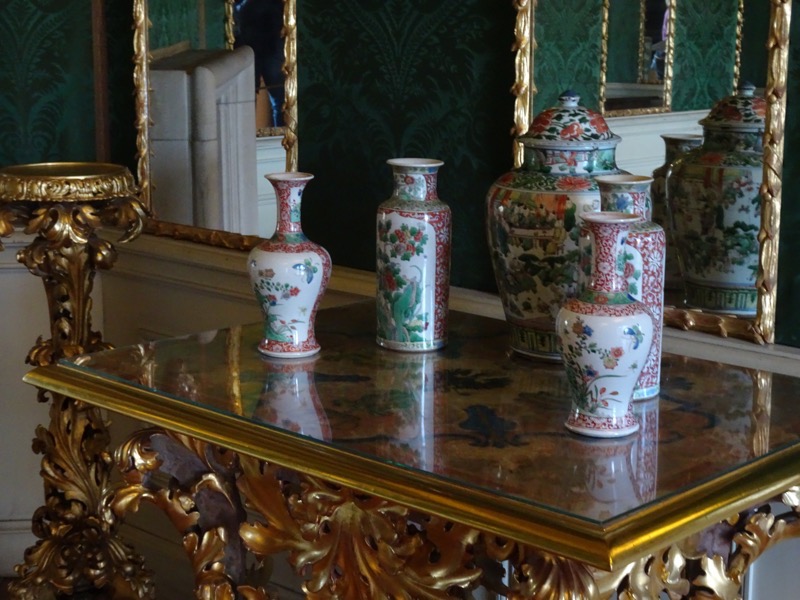 One of Sophie’s antechambers.
One of Sophie’s antechambers.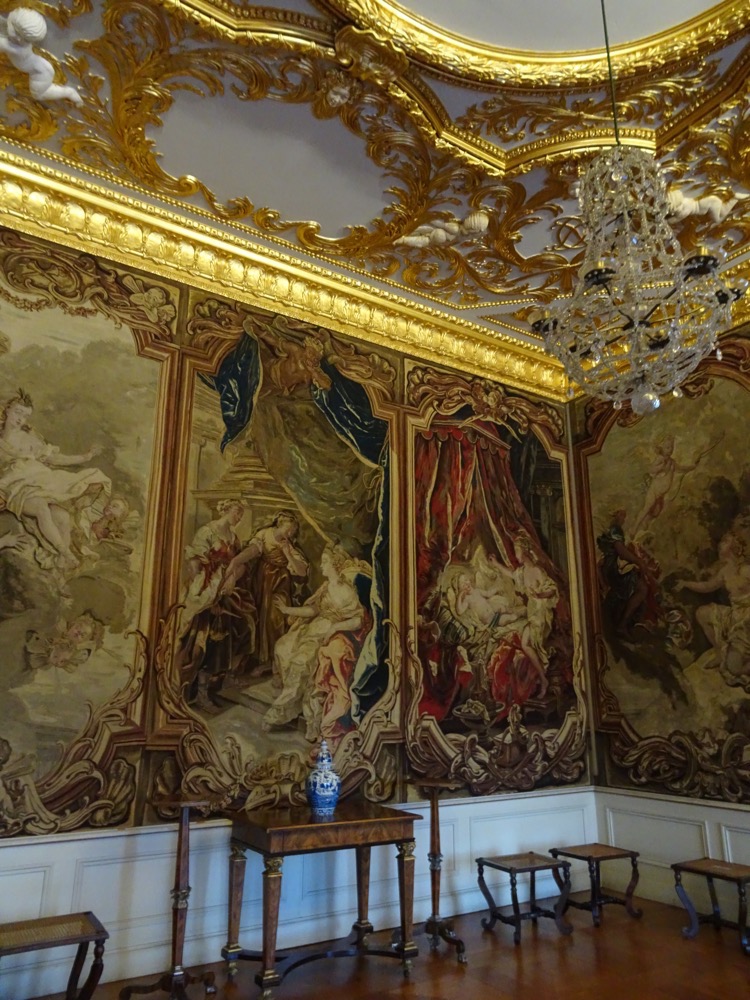
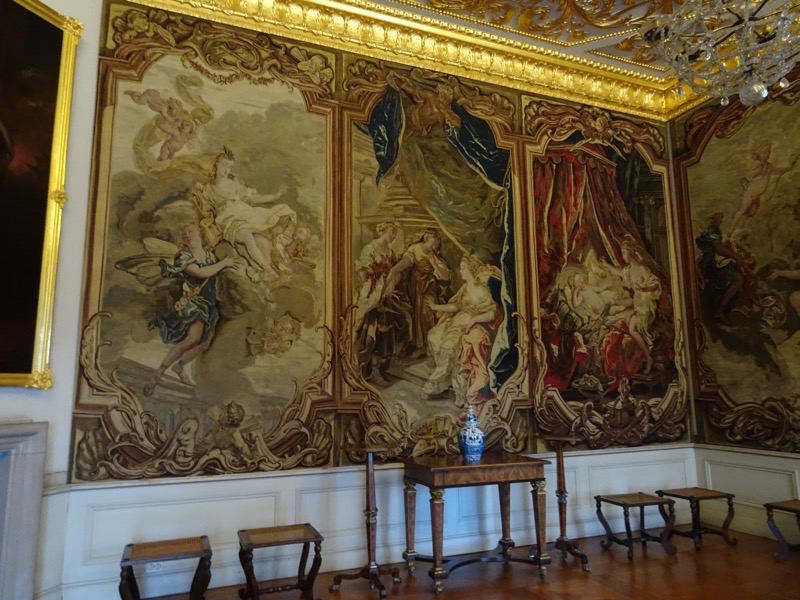 Cupid and Psyche are kinda evident everywhere.
Cupid and Psyche are kinda evident everywhere.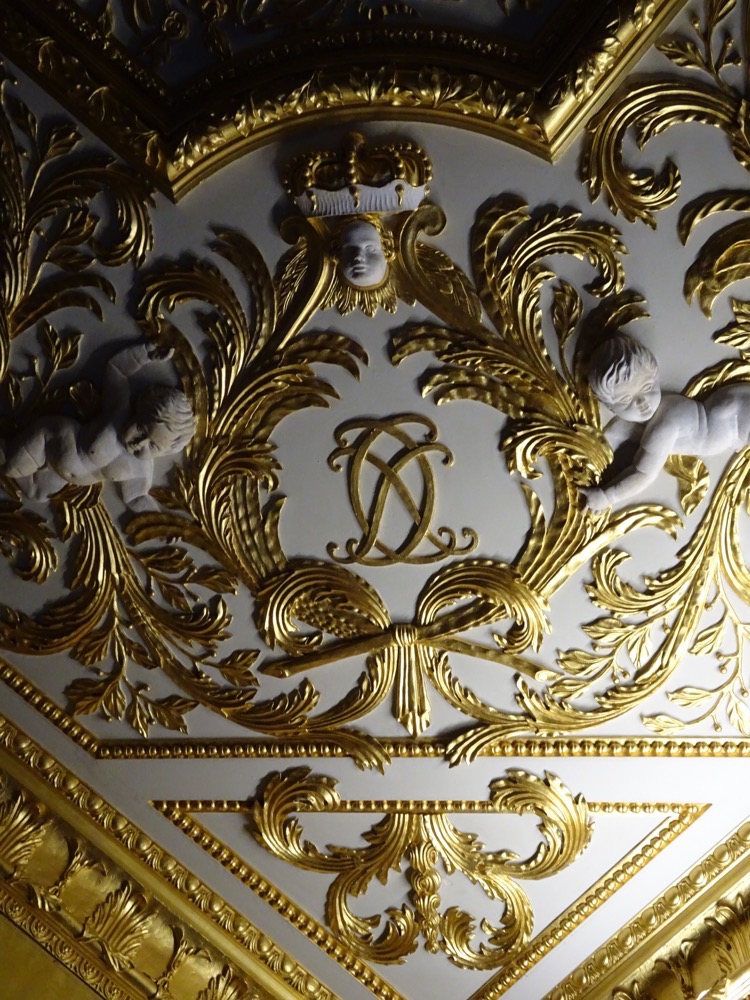 The Long Oval Hall was an entrance and recption area before the palace was extended, after which it became one of Sophie’s private rooms, it has exceptional views out to the gardens. But again was severly damaged in WWII so has also been recreated.
The Long Oval Hall was an entrance and recption area before the palace was extended, after which it became one of Sophie’s private rooms, it has exceptional views out to the gardens. But again was severly damaged in WWII so has also been recreated.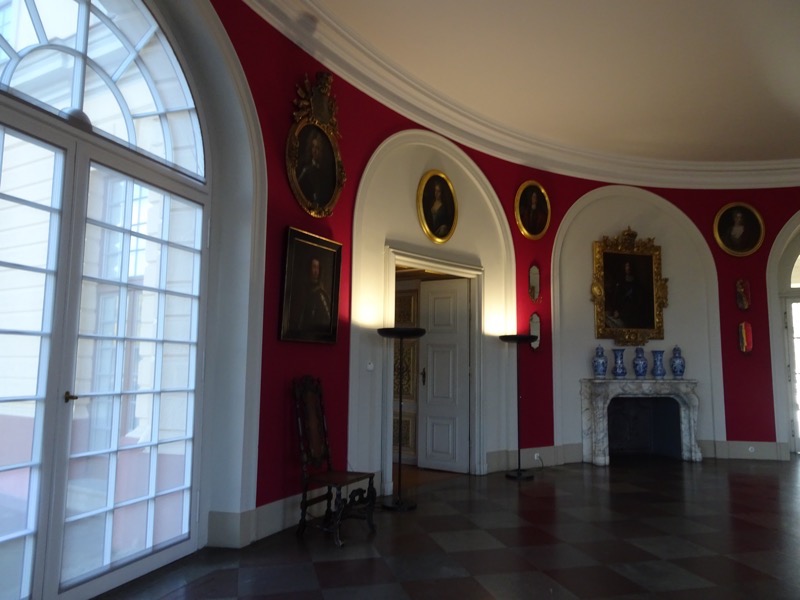 As we moved through the Palace we noticed quite a few chinoiserie ceramics. There seemed to be quite a lot of them for a palace of this style/age… little did we know.
As we moved through the Palace we noticed quite a few chinoiserie ceramics. There seemed to be quite a lot of them for a palace of this style/age… little did we know.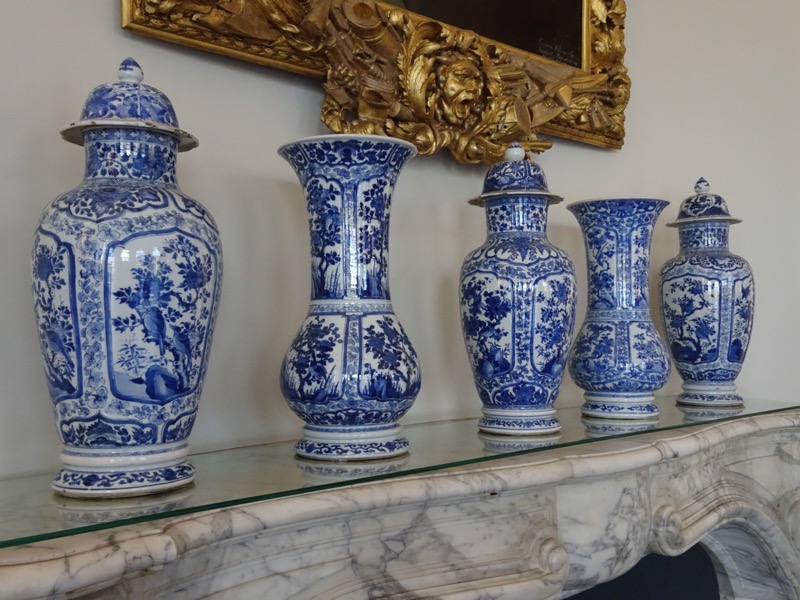 The Long Oval overlooked the formal gardens.
The Long Oval overlooked the formal gardens.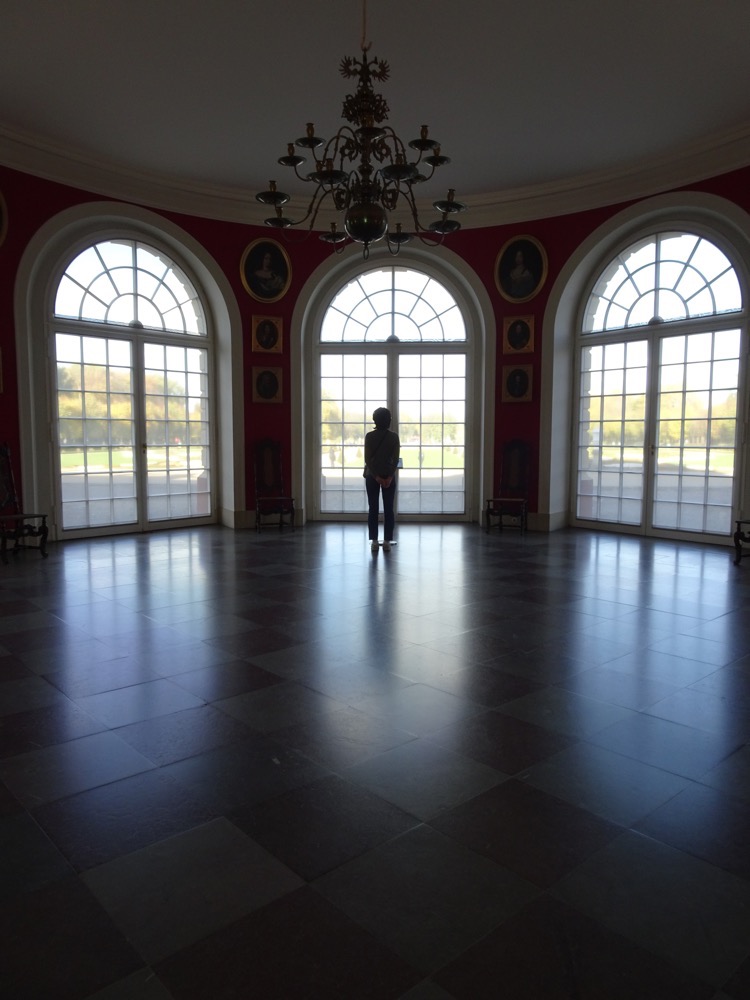
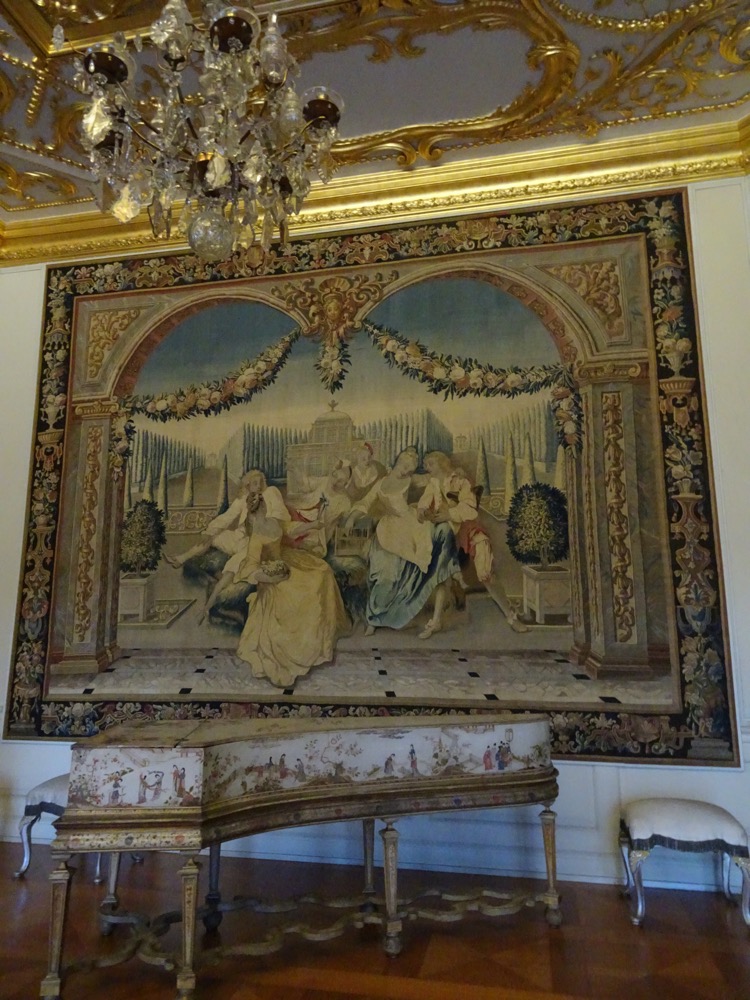 After Sophie’s death, Frederick used her second antechamber as a small audience chamber. The tapestries were added in 1740 by his grandson, however, all in here was also damaged so is copied or reconstructed. One of the placards I read in here said all the fireplaces had been deliberately built to have consoles for displaying porcelain.
After Sophie’s death, Frederick used her second antechamber as a small audience chamber. The tapestries were added in 1740 by his grandson, however, all in here was also damaged so is copied or reconstructed. One of the placards I read in here said all the fireplaces had been deliberately built to have consoles for displaying porcelain.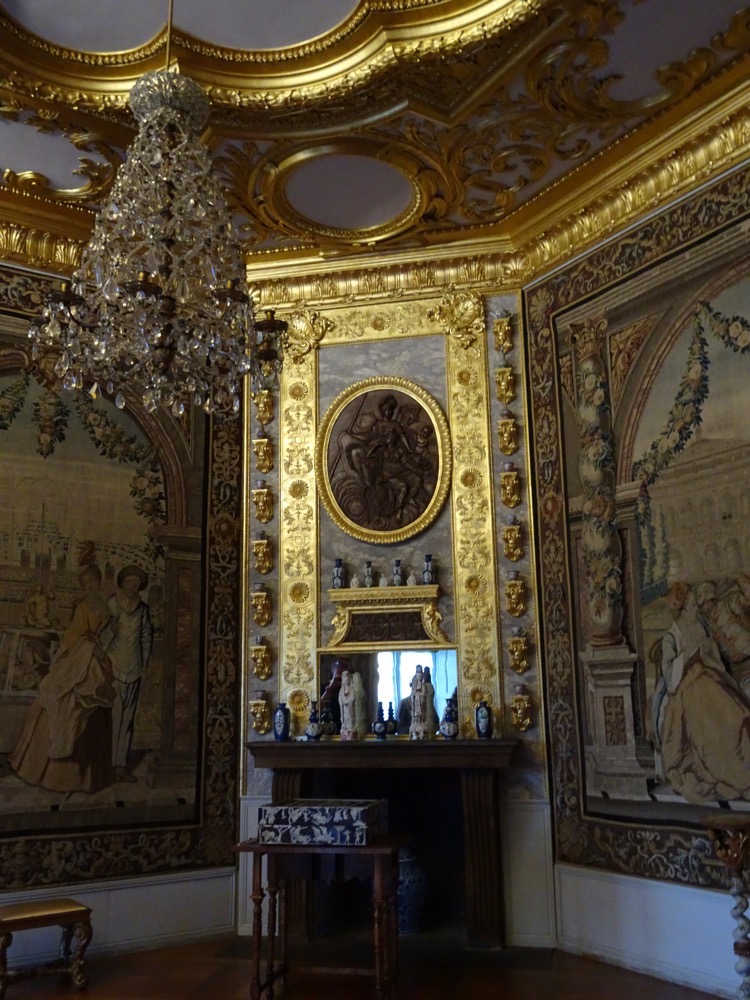
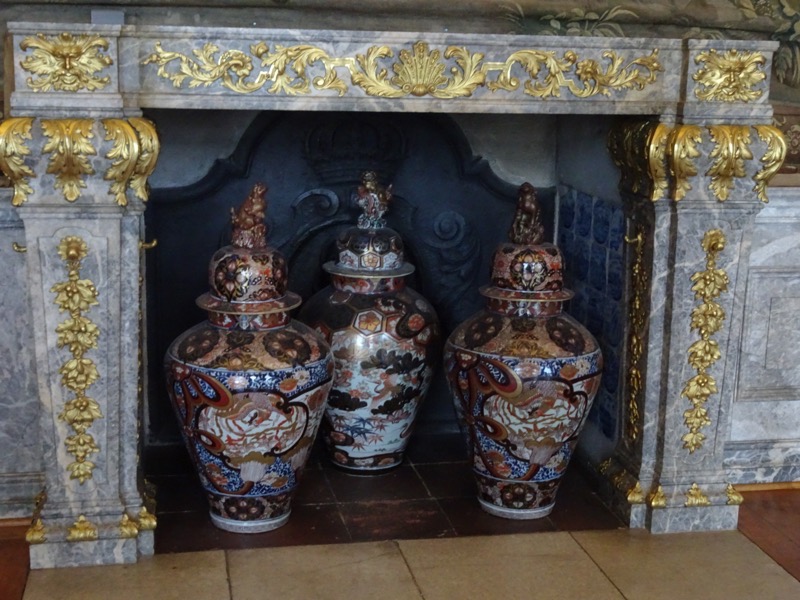
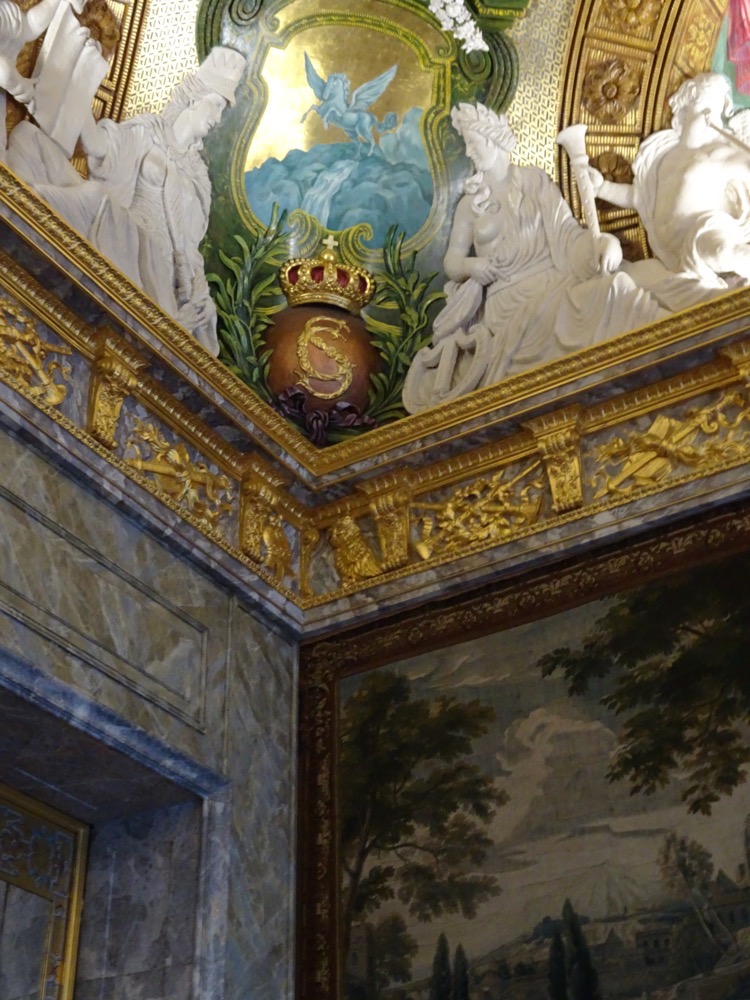 Another audience chamber, also demonstrating their particular fondness for ceramics.
Another audience chamber, also demonstrating their particular fondness for ceramics.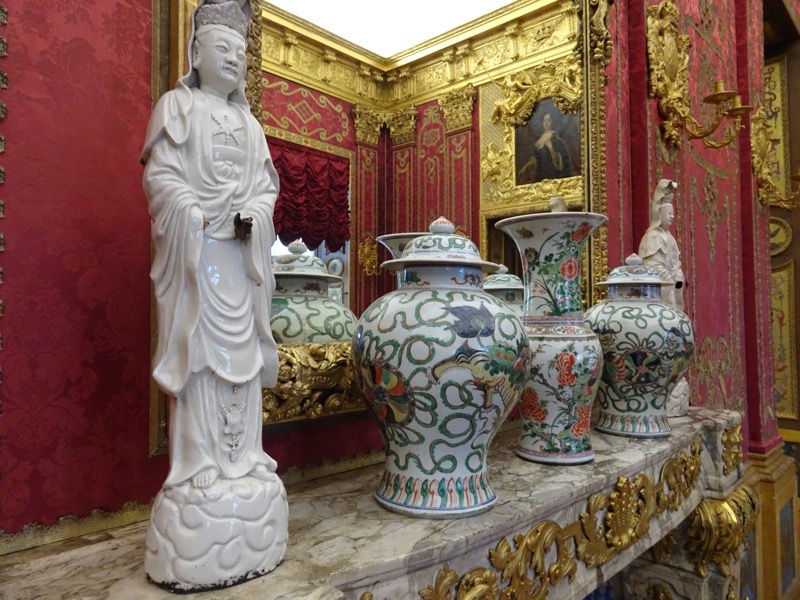
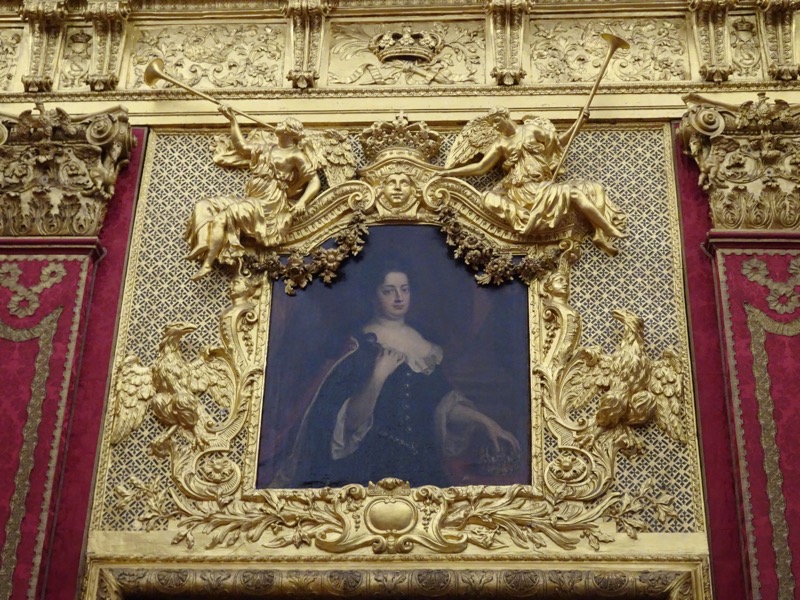 And a third audience chamber… there was little to indicate whether all these audience chambers served different purposes or were for people of varying levels of acquaintance (well nothing I saw in English anyway). However, this room indicated that it was for private audiences with intimate members of the family and the King and his guest would have chairs of equal size. It also had the most amazing ceiling that is painted on canvas and survived the war, so it is the original art.
And a third audience chamber… there was little to indicate whether all these audience chambers served different purposes or were for people of varying levels of acquaintance (well nothing I saw in English anyway). However, this room indicated that it was for private audiences with intimate members of the family and the King and his guest would have chairs of equal size. It also had the most amazing ceiling that is painted on canvas and survived the war, so it is the original art.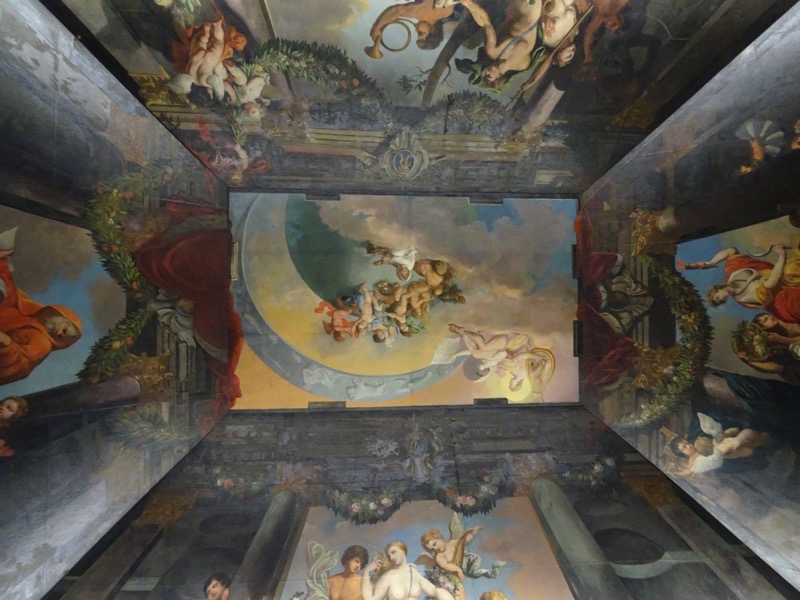 and more porcelain of course.
and more porcelain of course.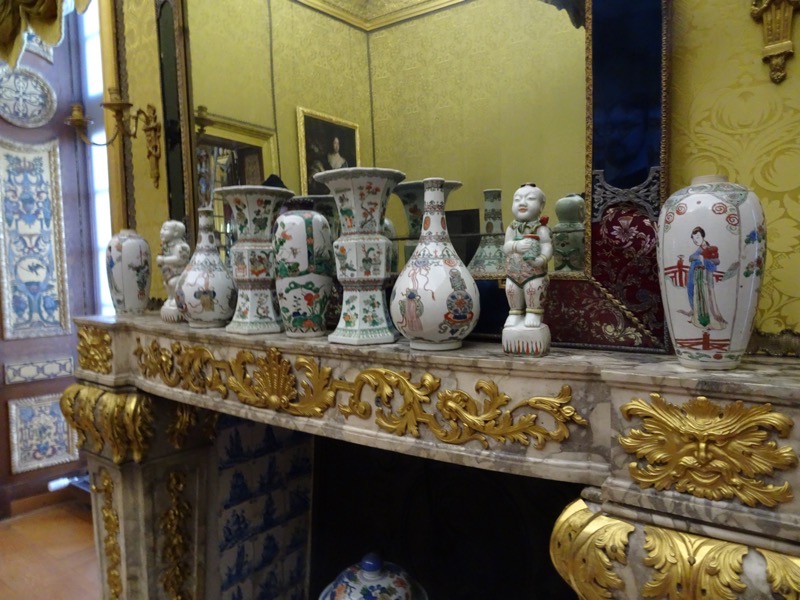
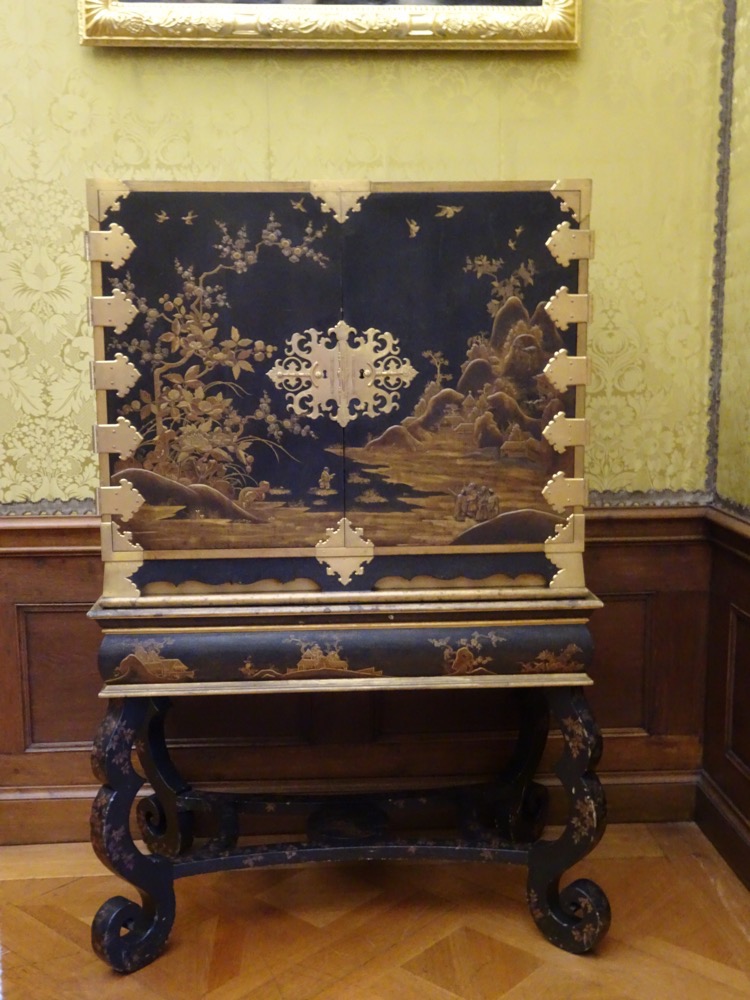 Which then led into ‘the Porcelain Cabinet’
Which then led into ‘the Porcelain Cabinet’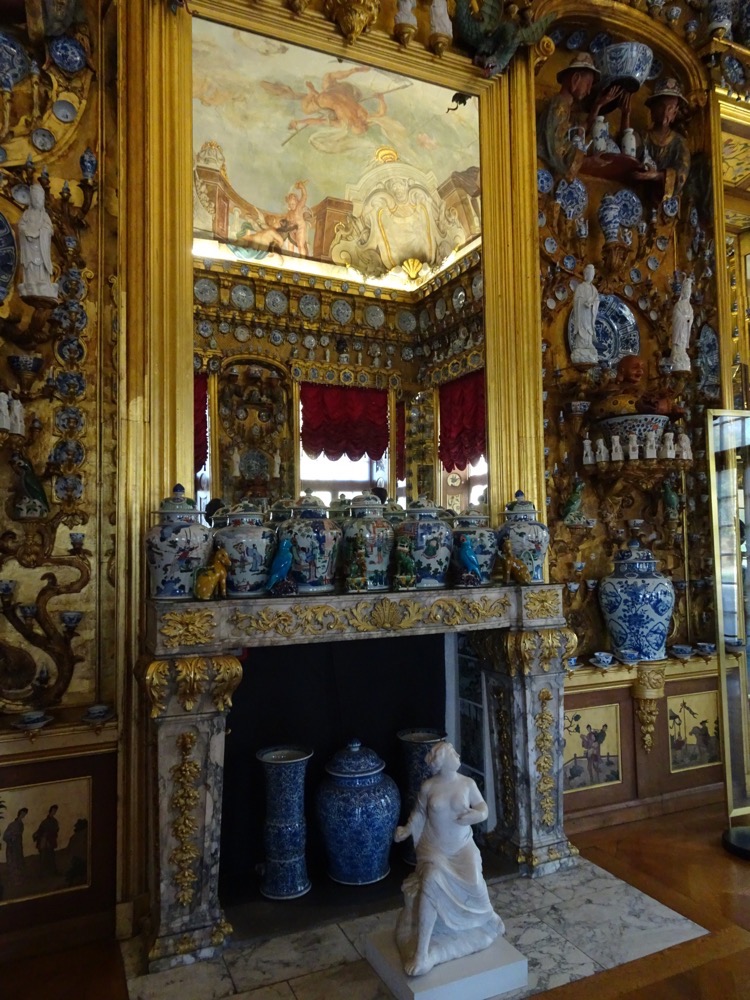 “The Porcelain Cabinet is the magnificent highlight of the 140m long flight of rooms on the palace’s garden side. However, when Sophie Charlotte died in 1705, the construction works were by no means finished and were not in fact completed until 1706. The walls have been designed in a way that shows the porcelain and figural motifs off to their best advantage. The ceiling murals painted in 1706 by Anthonie Coxie, are allegorical images glorifying the rise of the Prussian royal dynasty. The Cabinet was heavily damaged in 1943 and restored in 1967.”
“The Porcelain Cabinet is the magnificent highlight of the 140m long flight of rooms on the palace’s garden side. However, when Sophie Charlotte died in 1705, the construction works were by no means finished and were not in fact completed until 1706. The walls have been designed in a way that shows the porcelain and figural motifs off to their best advantage. The ceiling murals painted in 1706 by Anthonie Coxie, are allegorical images glorifying the rise of the Prussian royal dynasty. The Cabinet was heavily damaged in 1943 and restored in 1967.”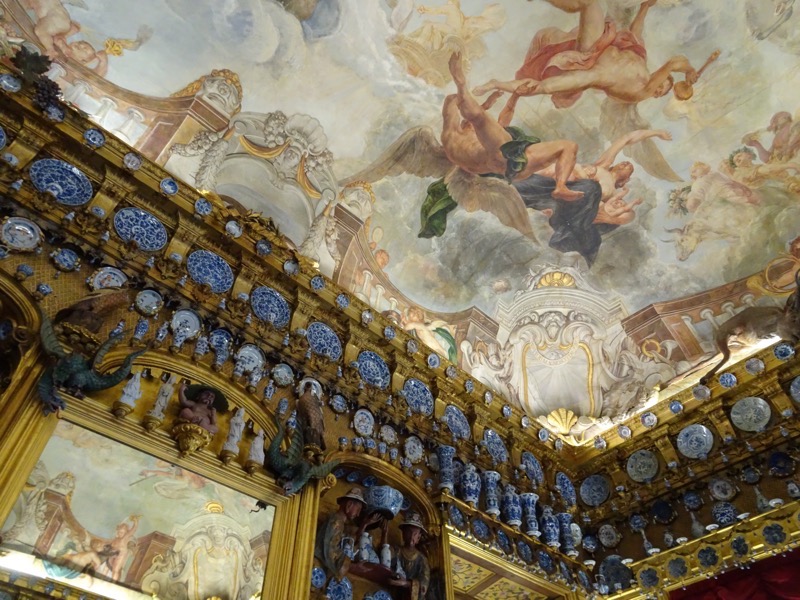 My how our sensibilities of what is ‘beautiful’ has changed.
My how our sensibilities of what is ‘beautiful’ has changed.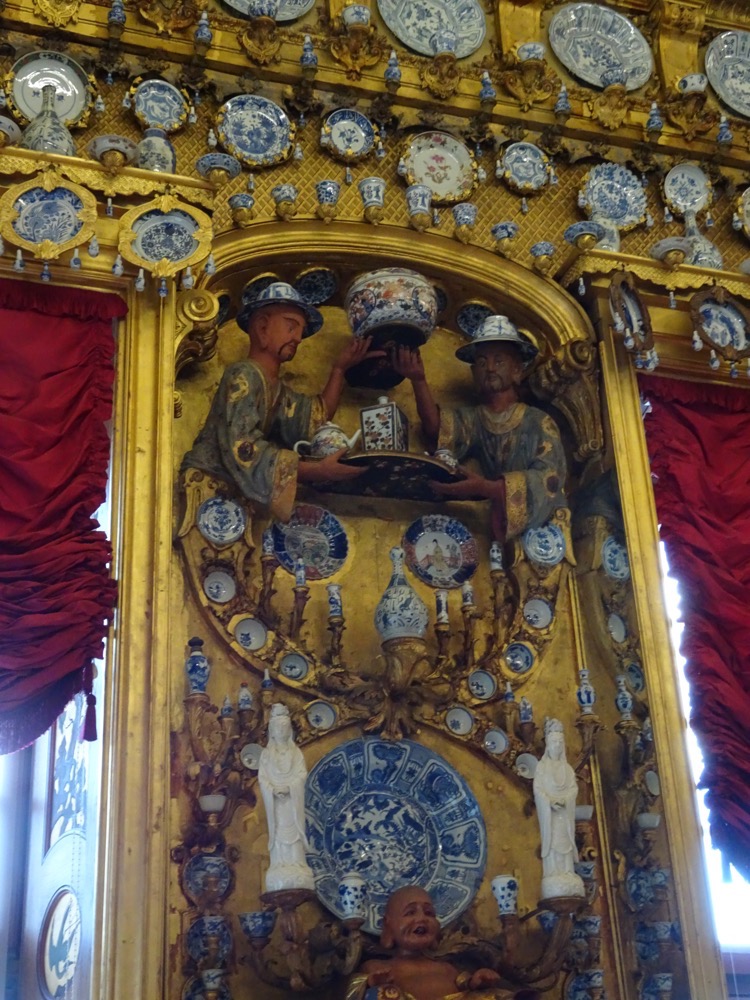
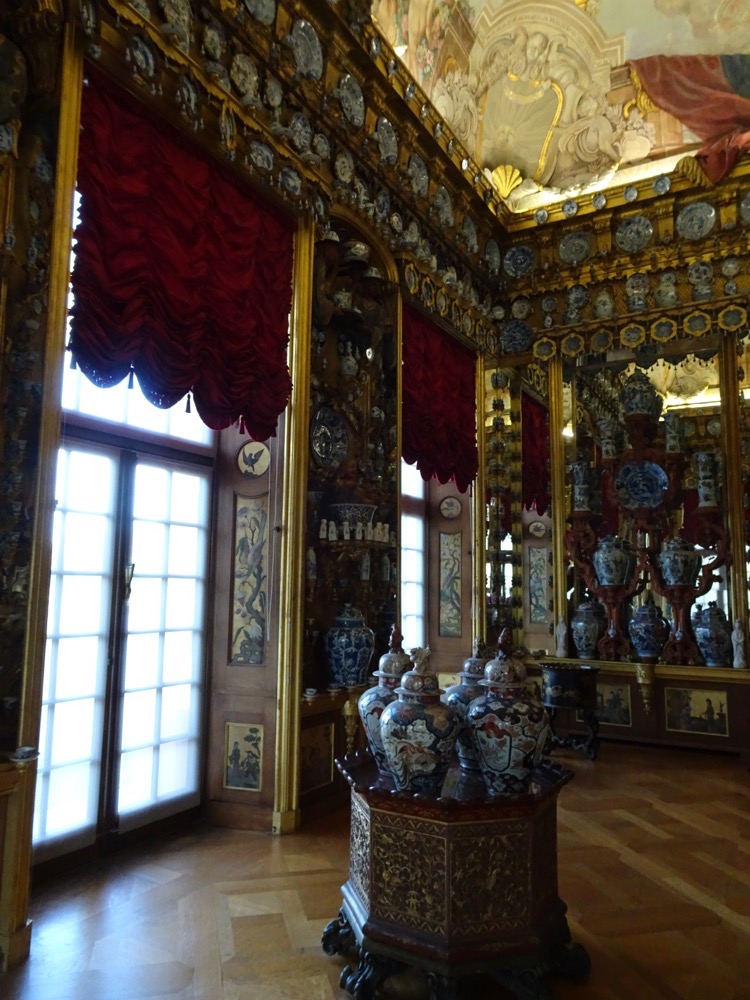 Next to the Porcelain Cabinet is the Royal Chapel – lavishly gilded and heavily ornamented.
Next to the Porcelain Cabinet is the Royal Chapel – lavishly gilded and heavily ornamented.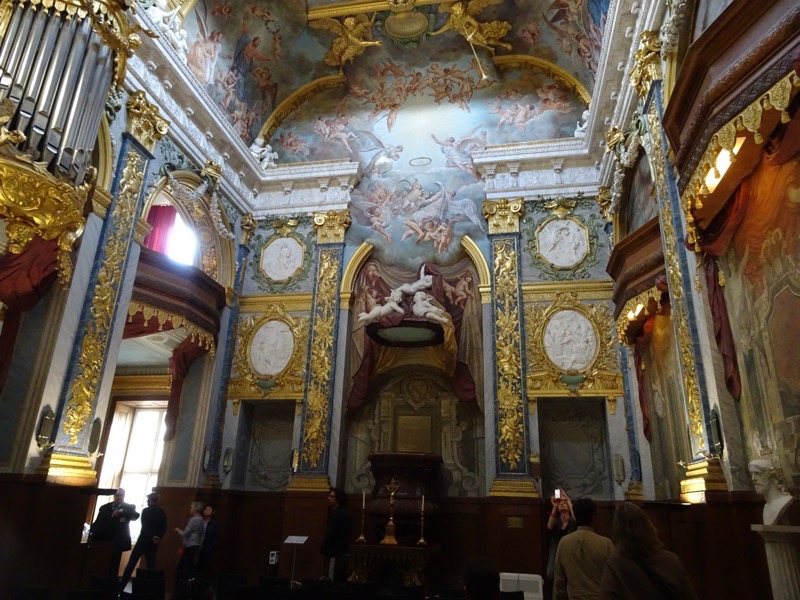
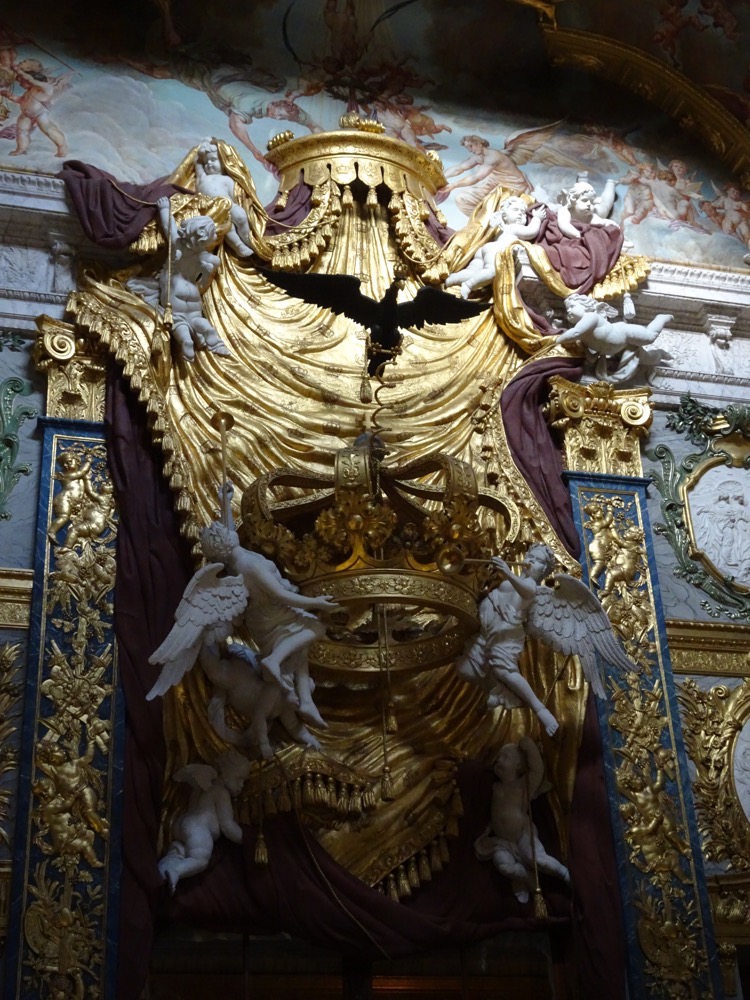
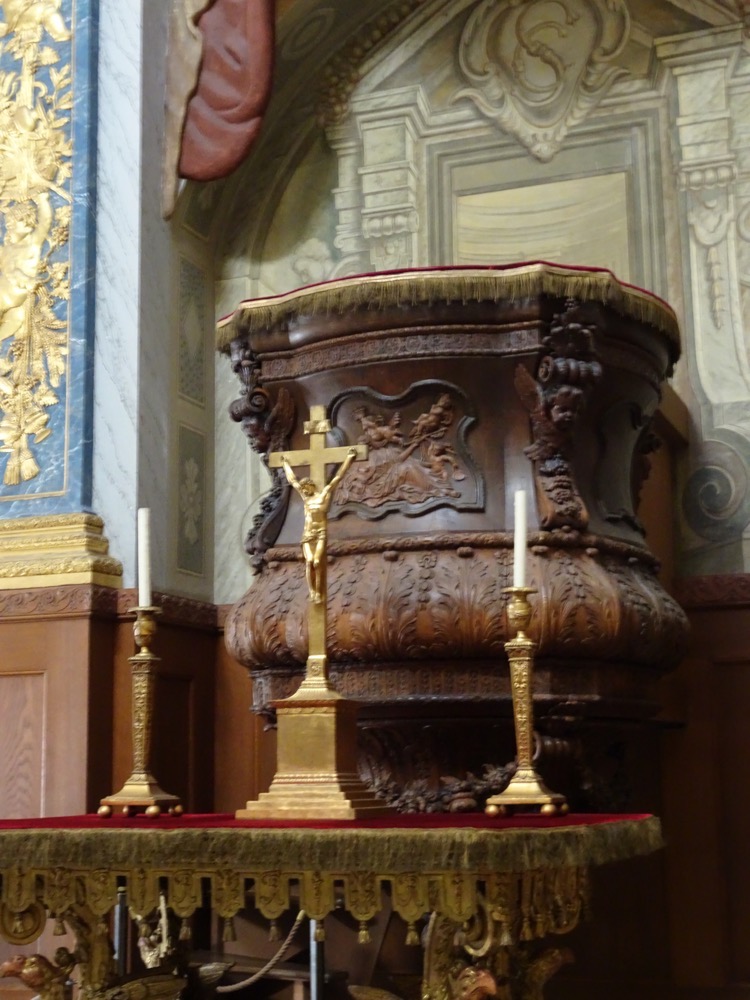 With its own miniature pipe organ.
With its own miniature pipe organ.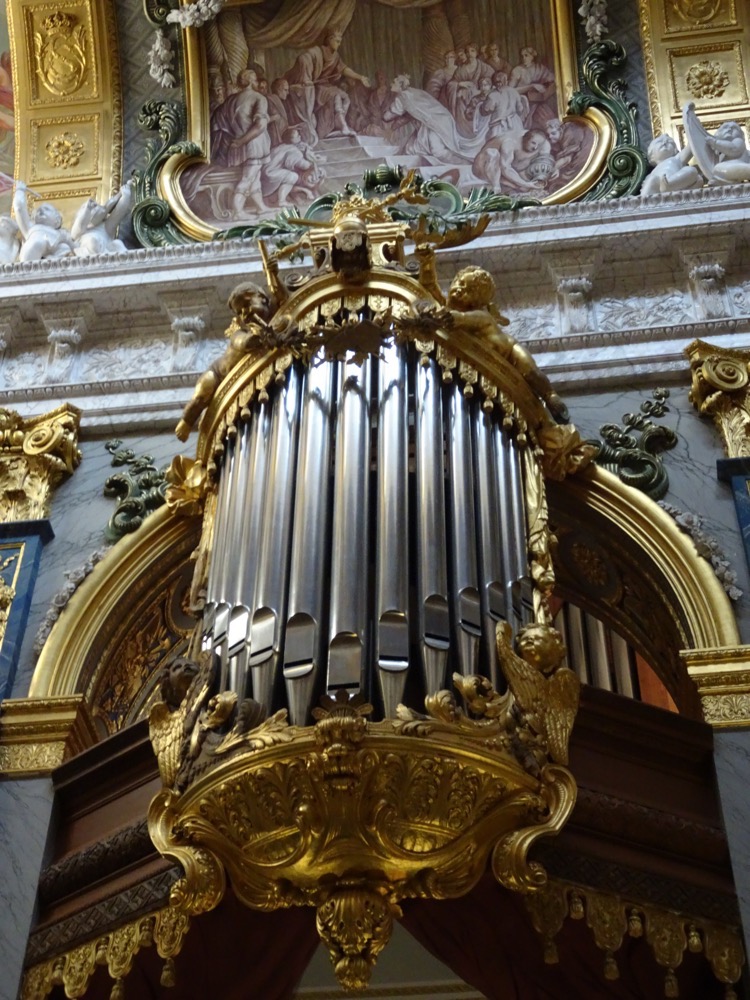 Portrait gallery on the way out.
Portrait gallery on the way out.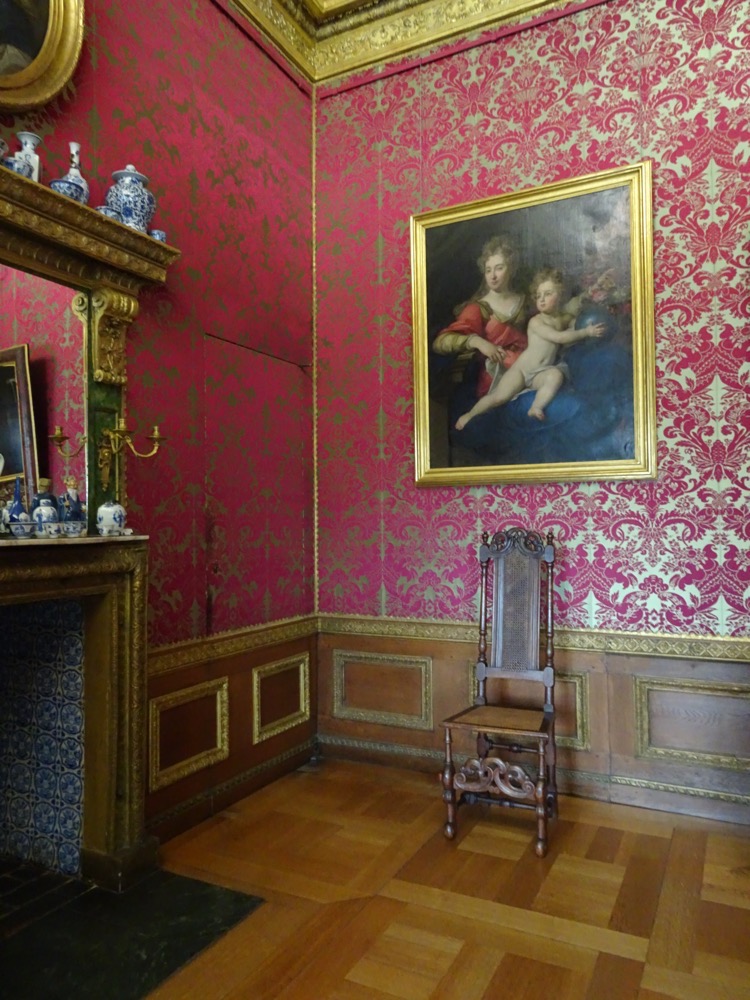
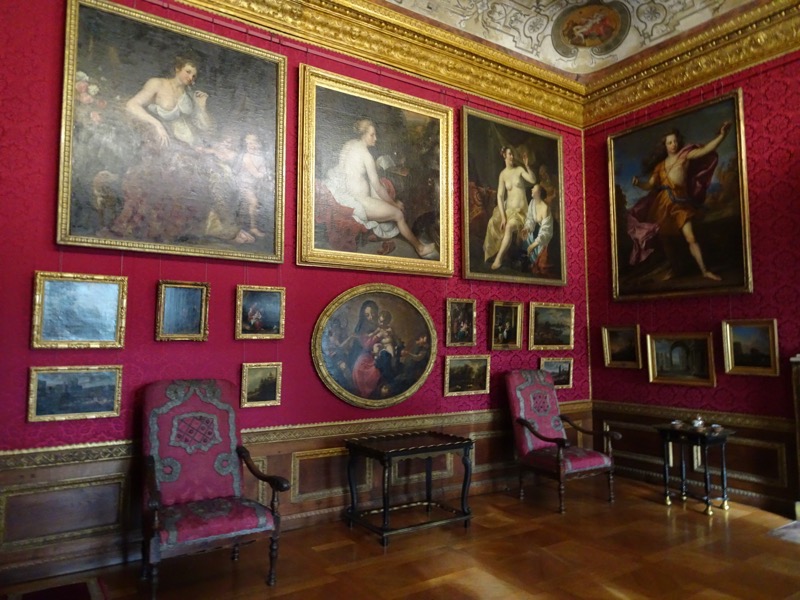
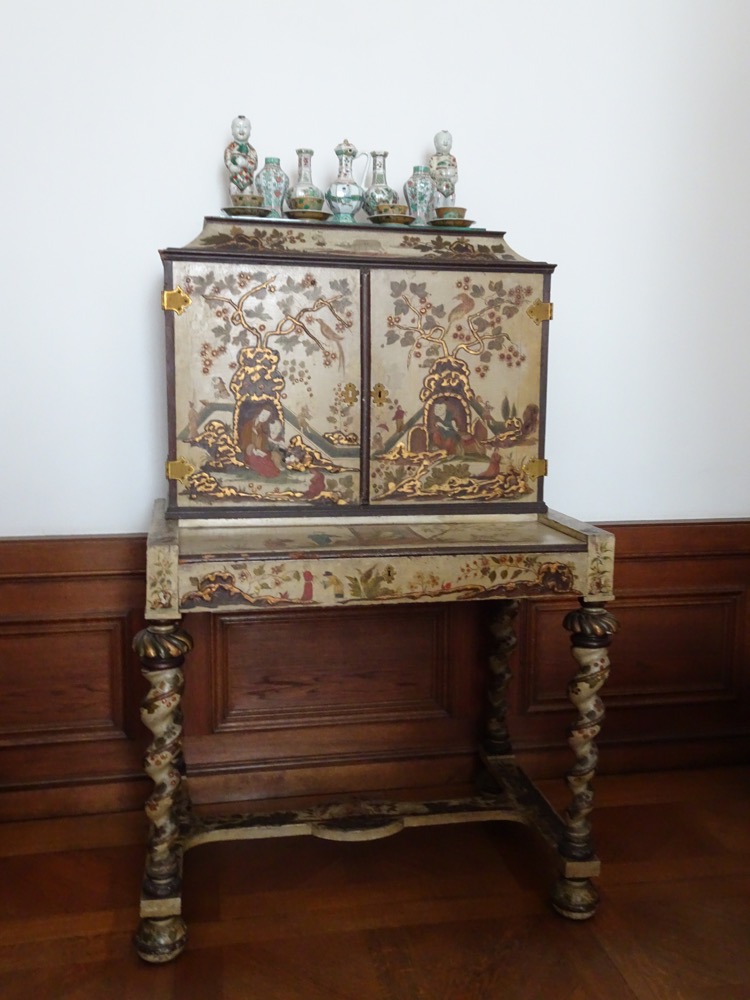 You exit through a servants entrance cleverly hidden under the stairs. The tour is supposed to continue on through the upper apartments, but there is a rope telling us it is closed. This is most likely due to the fact that it is October and they don’t want to staff the entire Palace for the winter, so we missed out on another 140m of lavish apartments upstairs.
You exit through a servants entrance cleverly hidden under the stairs. The tour is supposed to continue on through the upper apartments, but there is a rope telling us it is closed. This is most likely due to the fact that it is October and they don’t want to staff the entire Palace for the winter, so we missed out on another 140m of lavish apartments upstairs.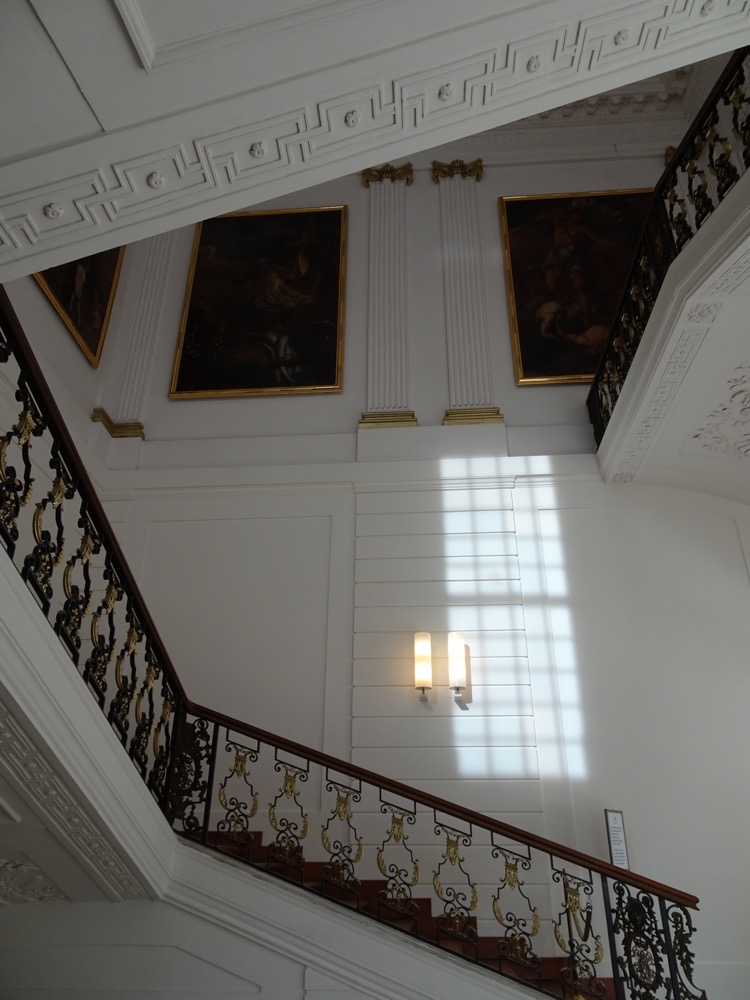 The weather had turned ‘moody’ while we were inside.
The weather had turned ‘moody’ while we were inside.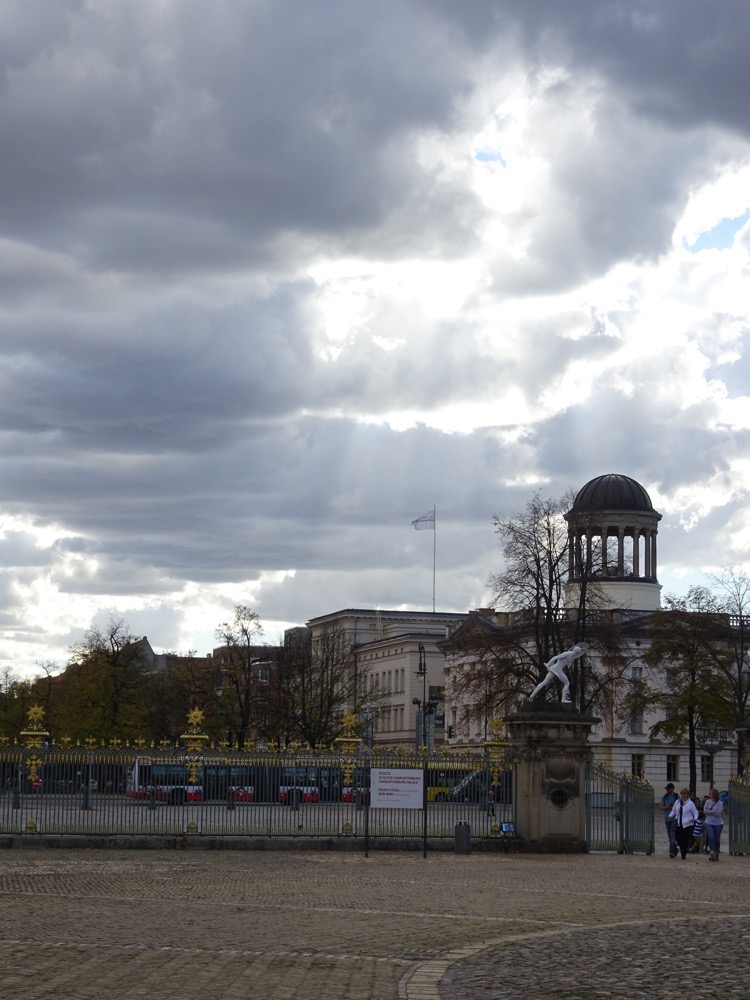
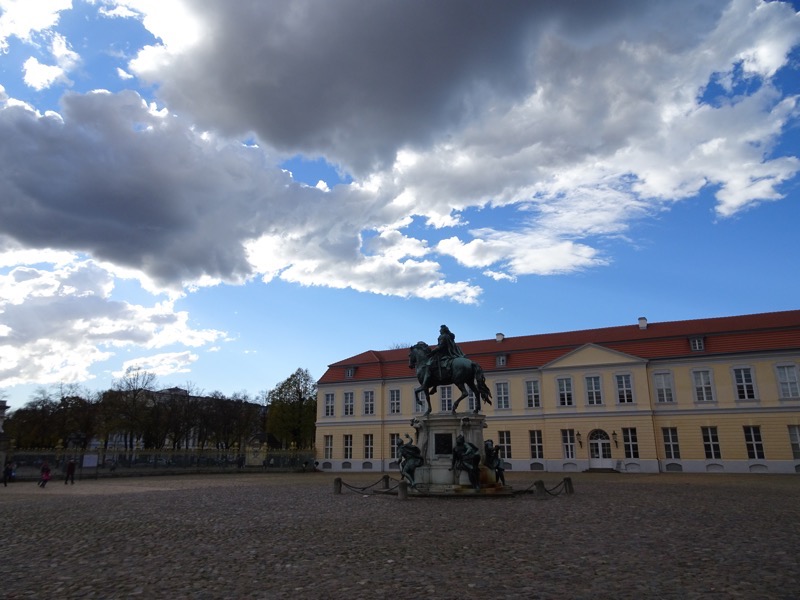 One for Leofric that I saw in the gift shop. 🙂
One for Leofric that I saw in the gift shop. 🙂 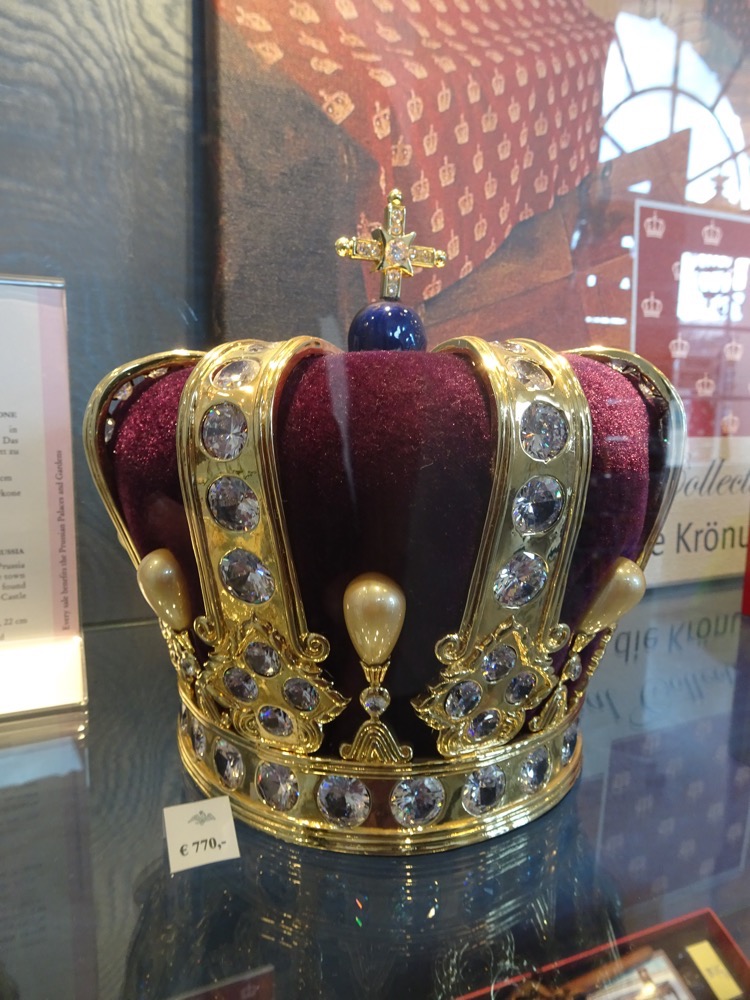 We walked around the back of the palace to see the formal gardens, but without an elevated viewpoint – it’s difficult to see the impressive design.
We walked around the back of the palace to see the formal gardens, but without an elevated viewpoint – it’s difficult to see the impressive design.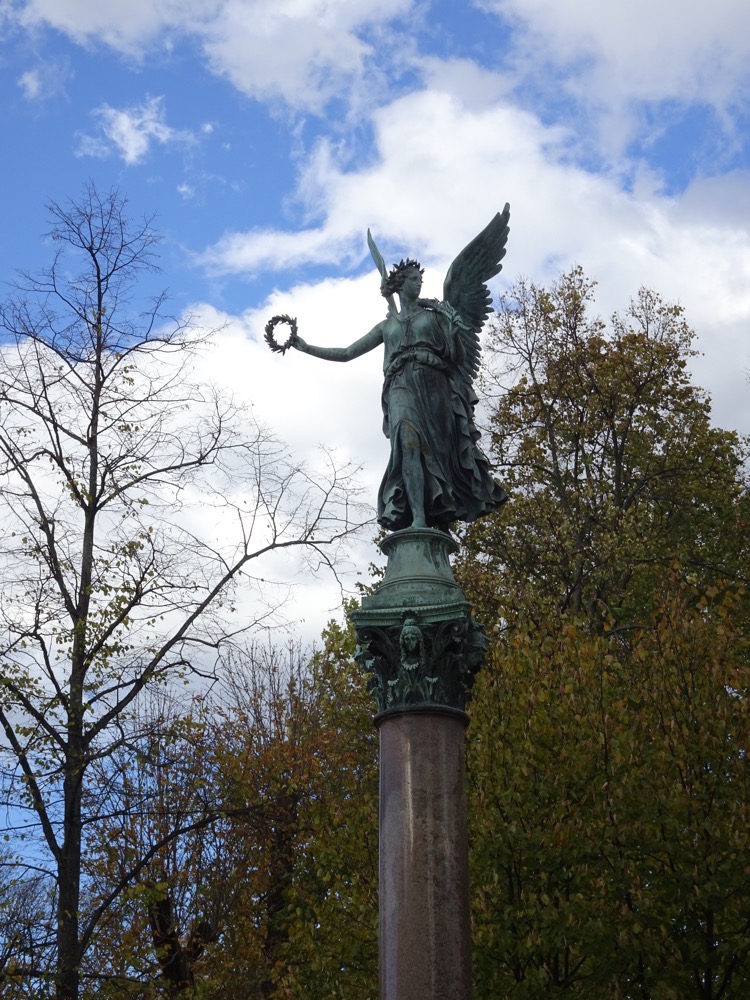
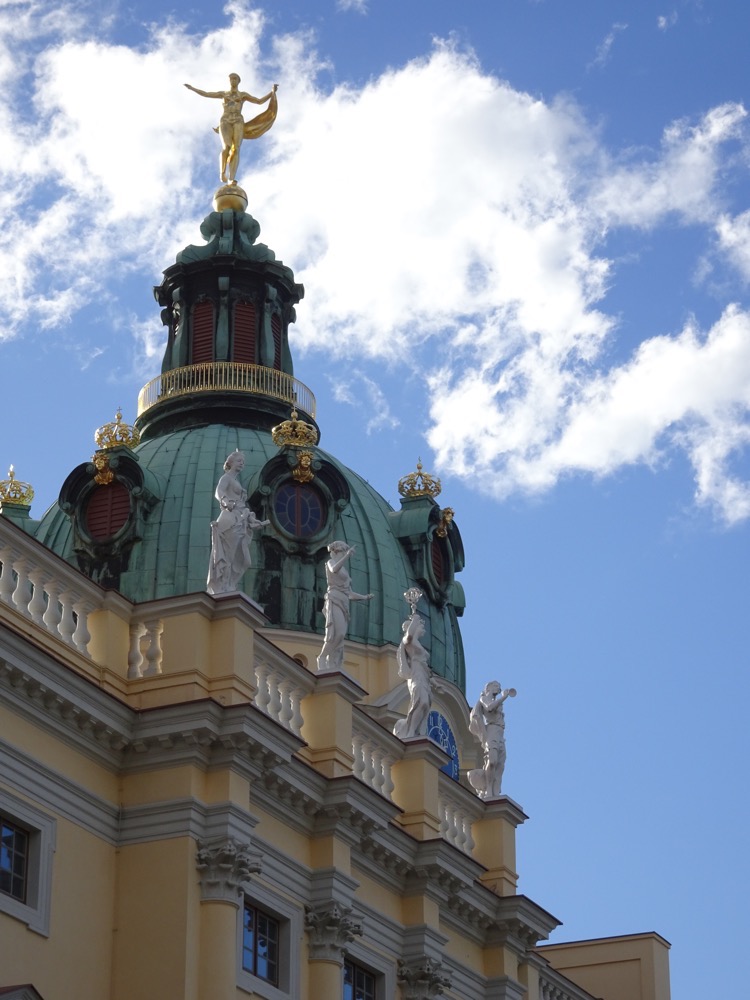

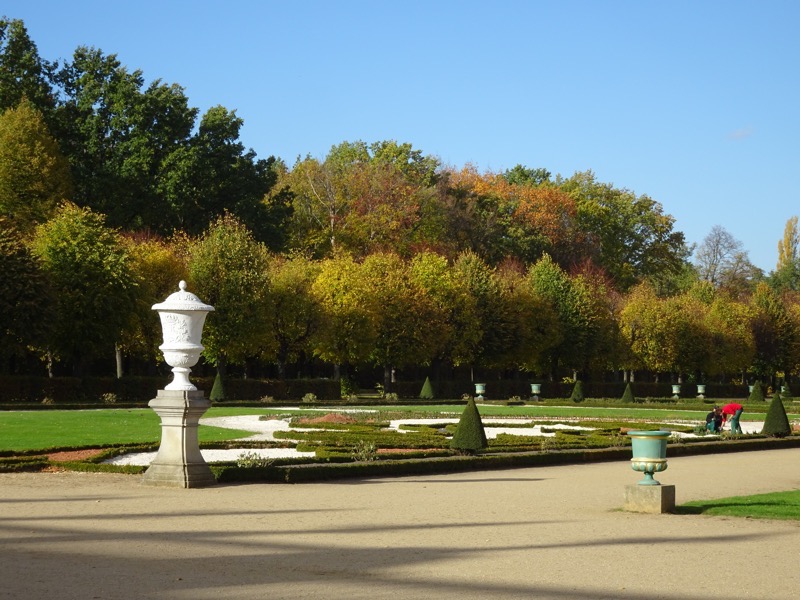
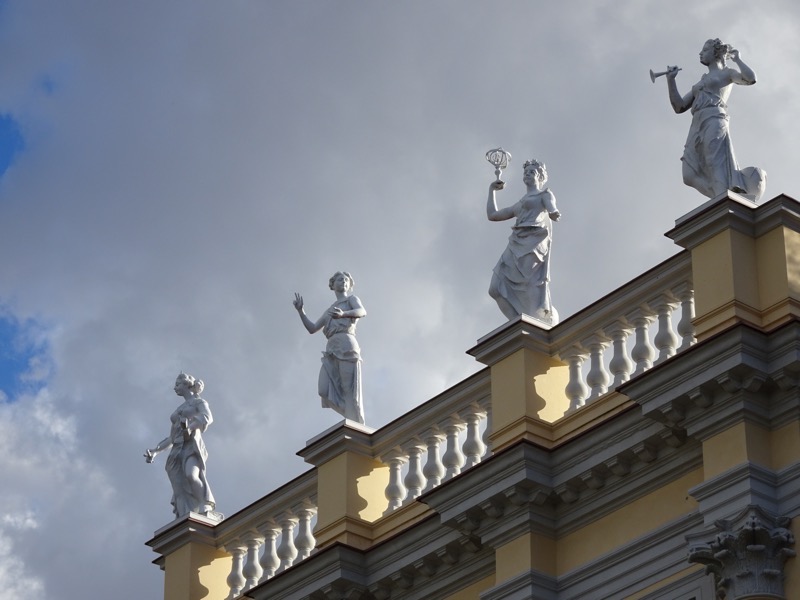
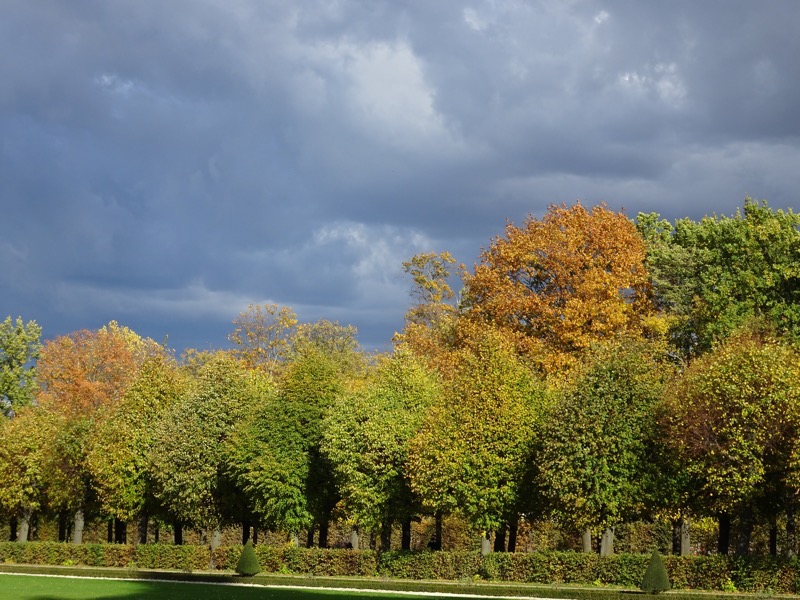
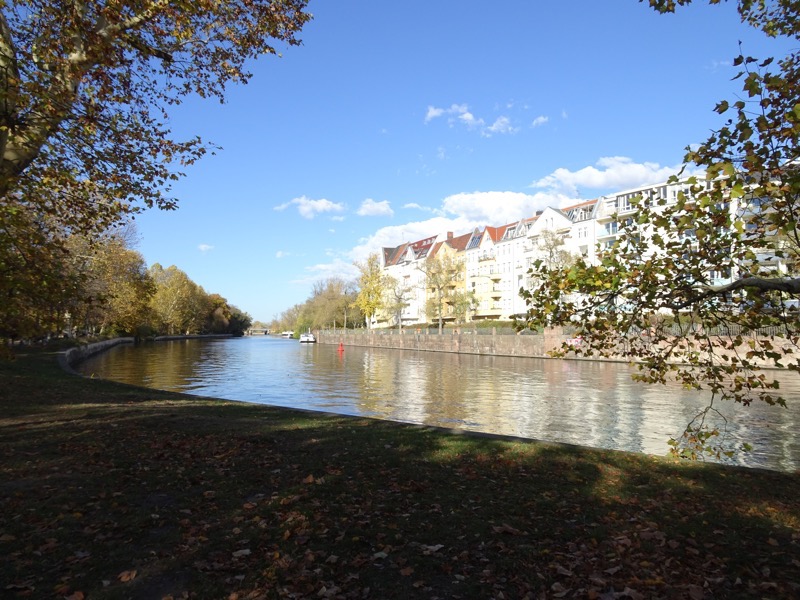
After a stroll around the gardens, we decided to stop into a Russian restaurant that is right across the street called, Samowar – it is one of the best 100 restaurants (our of over 9000) so we thought it would be a good bet. If you’re ever here, you should visit… they do what looks like an amazing Sunday buffet, and I imagine making a reservation would be necessary.
Calf’s liver with red cabbage, onions and mashed potato: 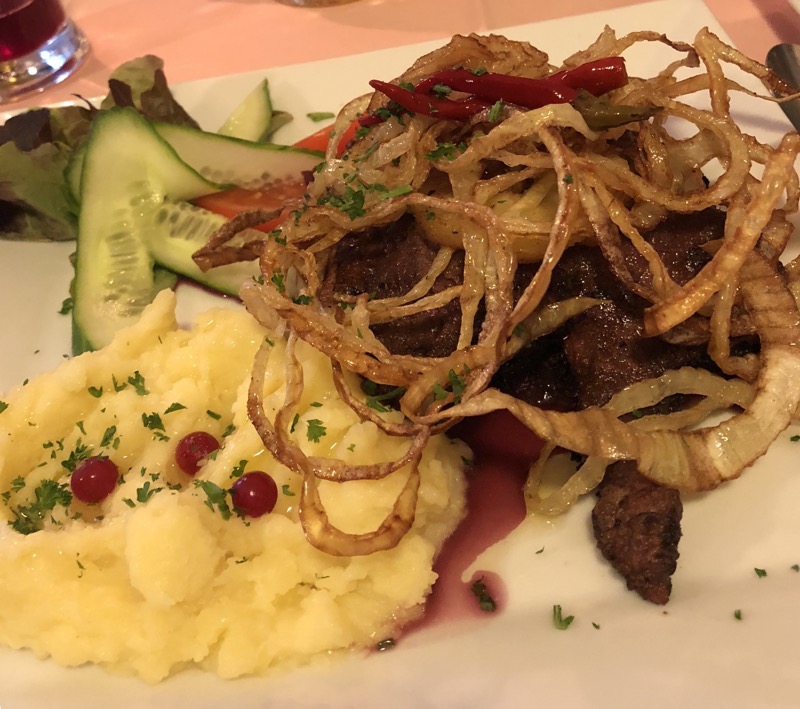 Wild boar sausage with pierogi :
Wild boar sausage with pierogi :
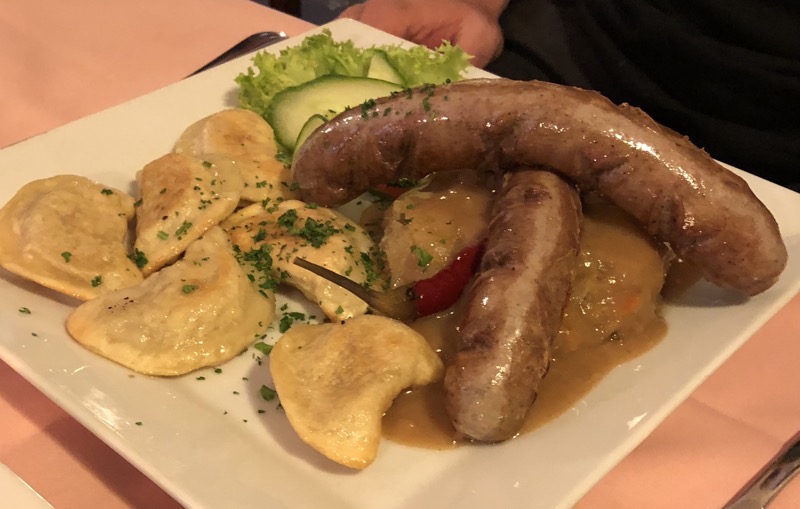 Last Russian honey cake until we go back to Russia or maybe do trans-Siberianan rail trip. 😛
Last Russian honey cake until we go back to Russia or maybe do trans-Siberianan rail trip. 😛
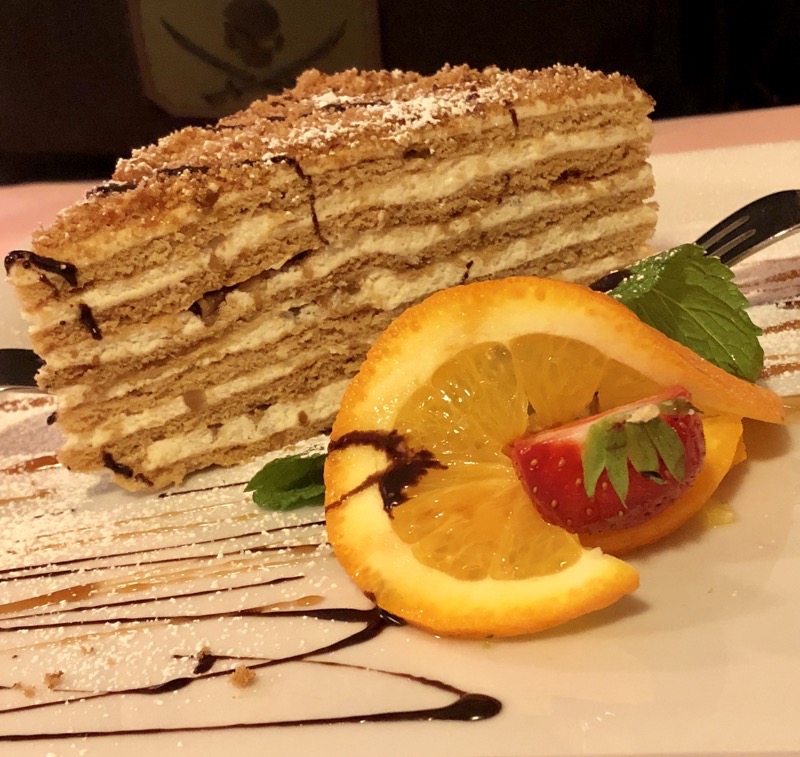 After lunch, we did some masterful navigating of Berlin’s bus and train systems to go see the East Side Gallery. The East Side Gallery is an open-air art gallery which consists of a series of large murals that have been painted directly onto a remnant of the Berlin Wall.
After lunch, we did some masterful navigating of Berlin’s bus and train systems to go see the East Side Gallery. The East Side Gallery is an open-air art gallery which consists of a series of large murals that have been painted directly onto a remnant of the Berlin Wall. 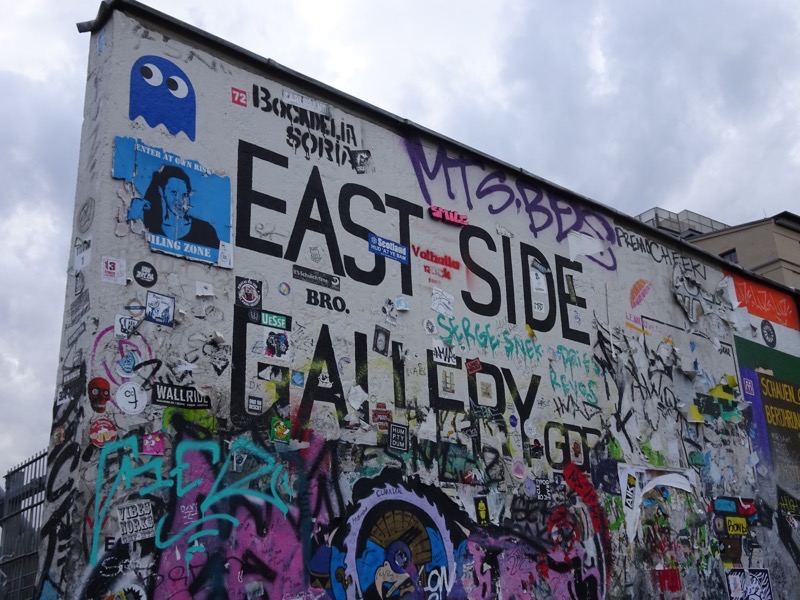
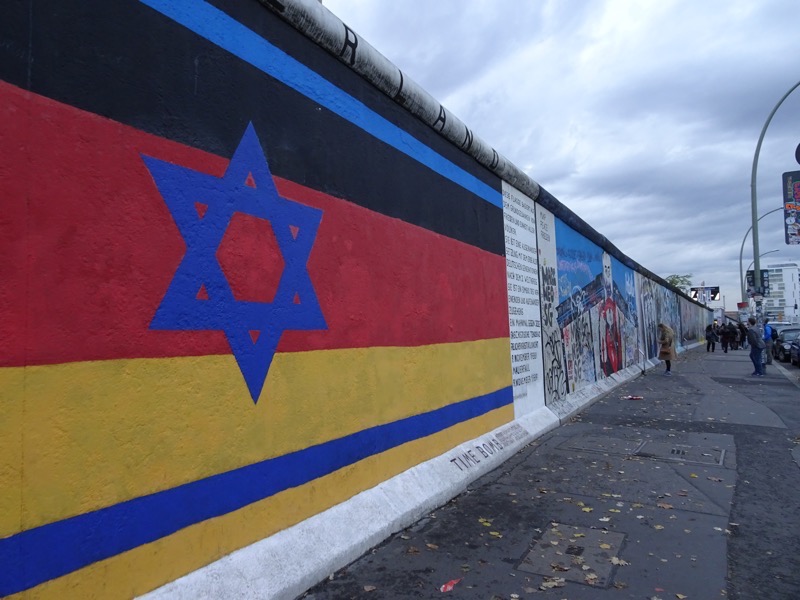 The paintings on Mühlenstraße started in 1990 and is over 1.3kms long making it the largest open-air art gallery in the world. There has been a lot of grafitti put on the artworks over the years, and some piece have been restored, but there is controversy over this with many artists refusing to re-do their artworks.
The paintings on Mühlenstraße started in 1990 and is over 1.3kms long making it the largest open-air art gallery in the world. There has been a lot of grafitti put on the artworks over the years, and some piece have been restored, but there is controversy over this with many artists refusing to re-do their artworks.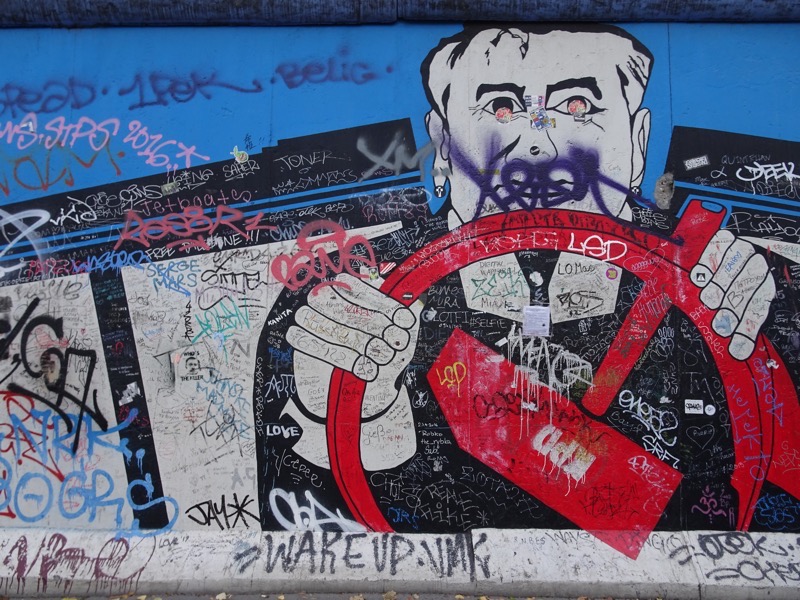
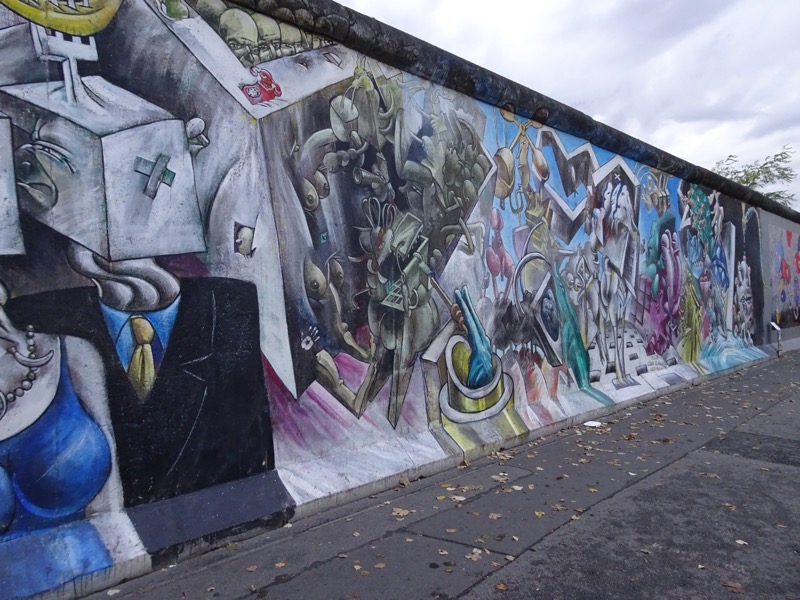 Today, it seems most of the art works are being left alone and not being grafitted, but there are areas of the wall where it seems grafitti is encouraged, as this is a living used space.
Today, it seems most of the art works are being left alone and not being grafitted, but there are areas of the wall where it seems grafitti is encouraged, as this is a living used space.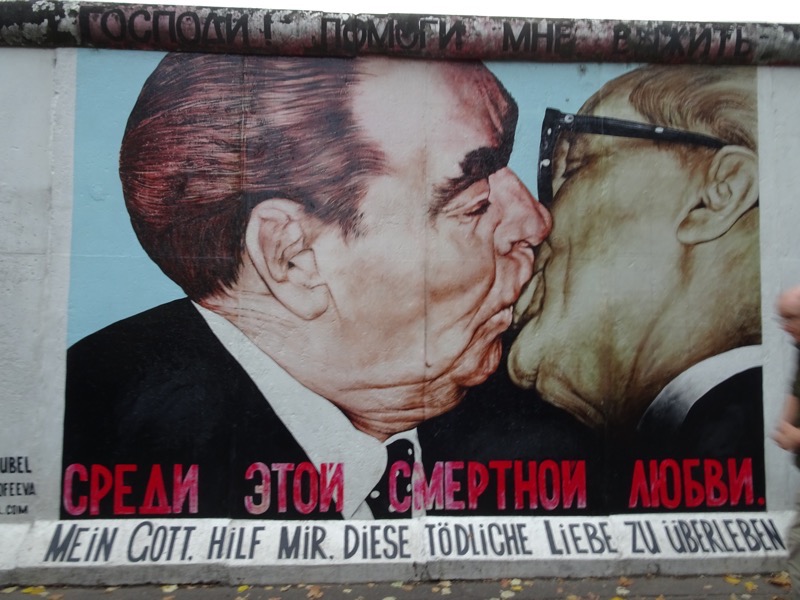 I love this: Moscow…walls; China… walls; Everywhere… no walls (with kangaroo!);, Berlin… walls.
I love this: Moscow…walls; China… walls; Everywhere… no walls (with kangaroo!);, Berlin… walls.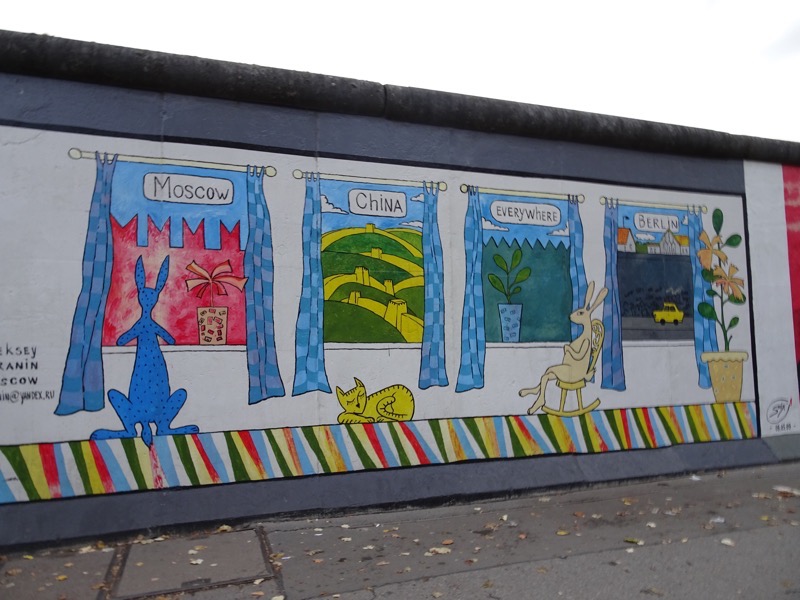 This section of wall is all grafitti… the big stenciled work is not an official piece.
This section of wall is all grafitti… the big stenciled work is not an official piece.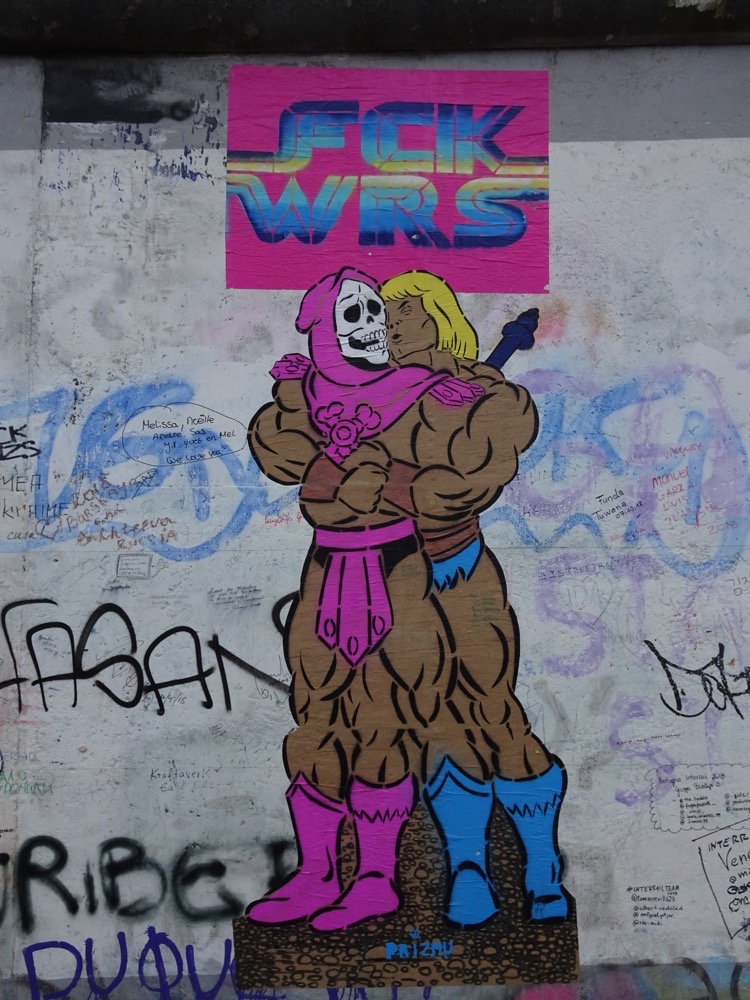 So we thought this was a good place to leave a small mark.
So we thought this was a good place to leave a small mark.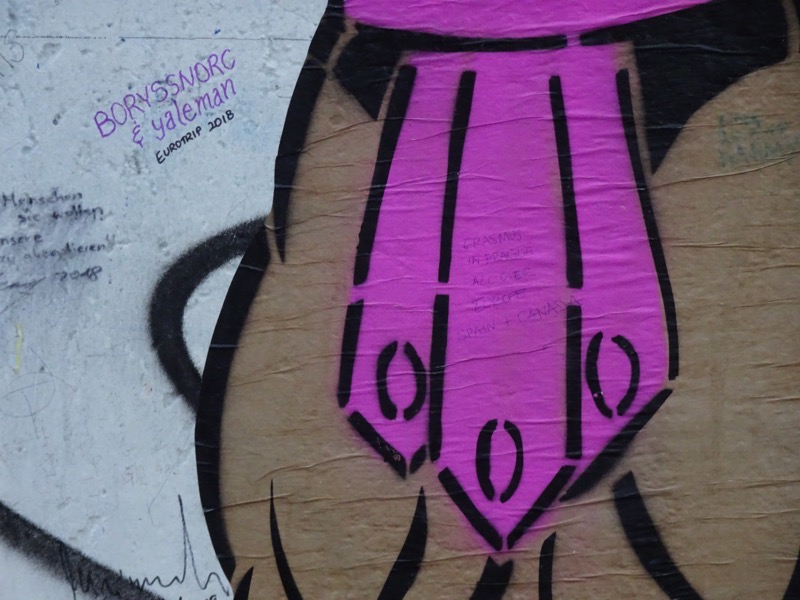
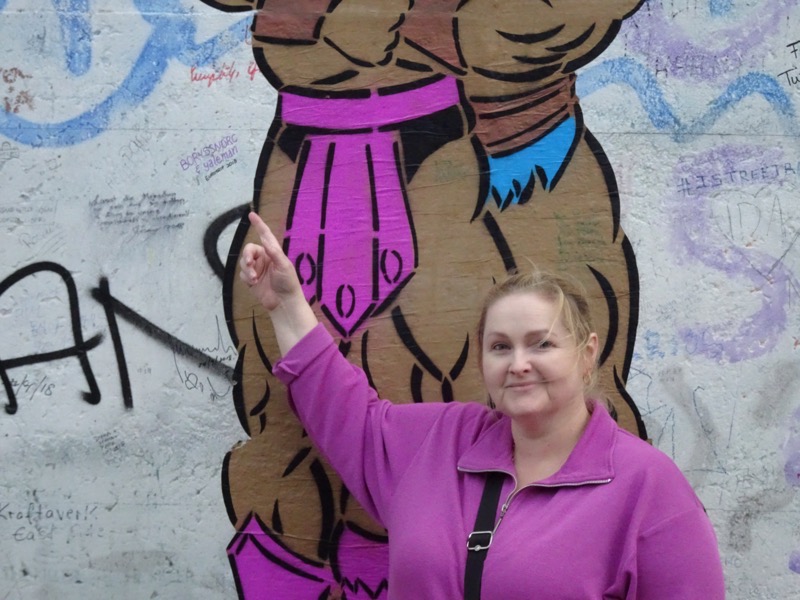
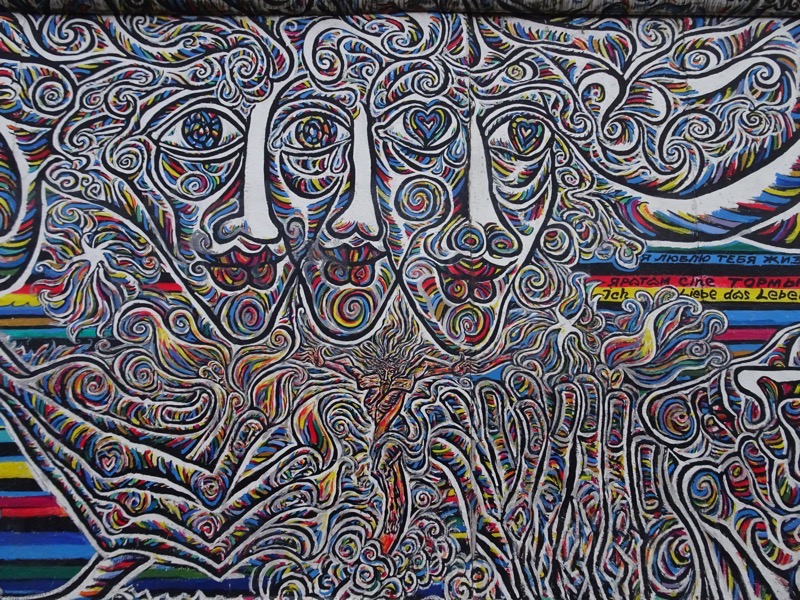
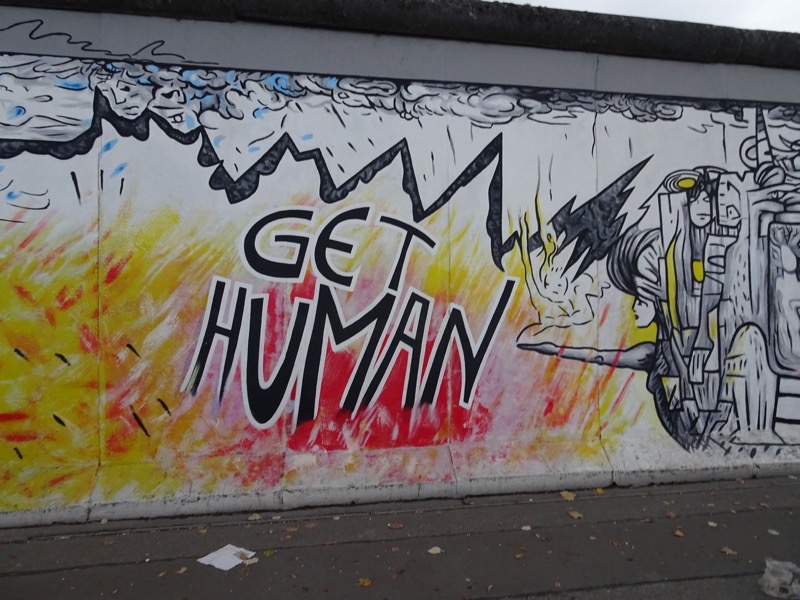
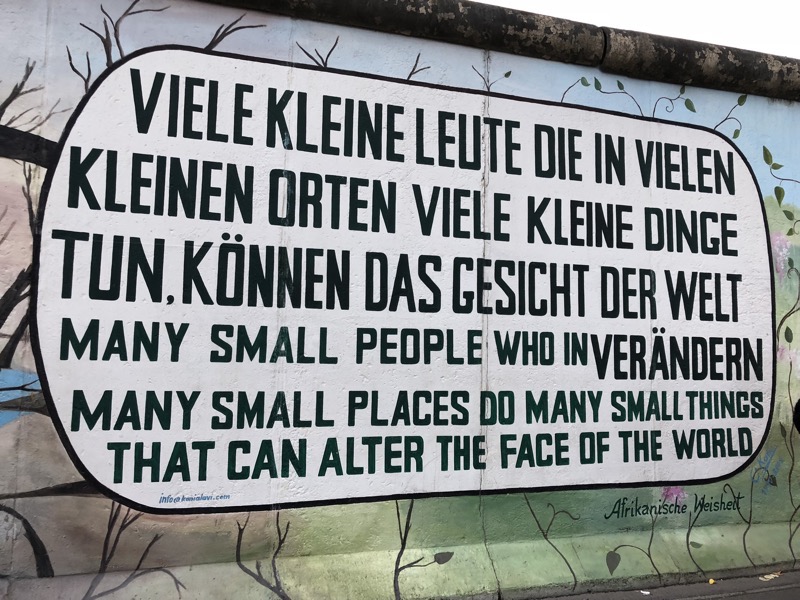
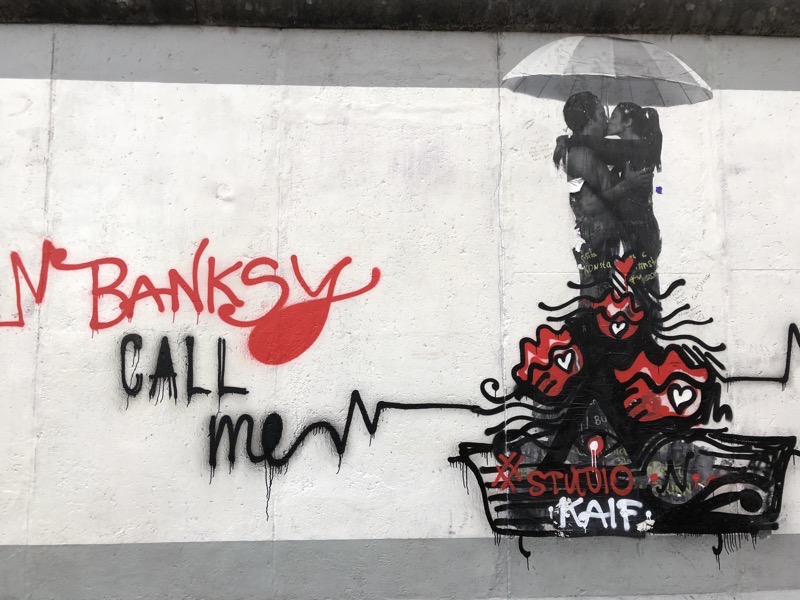
 I know my photos make it look all peaceful and orderly – but of course, it wasn’t.
I know my photos make it look all peaceful and orderly – but of course, it wasn’t.
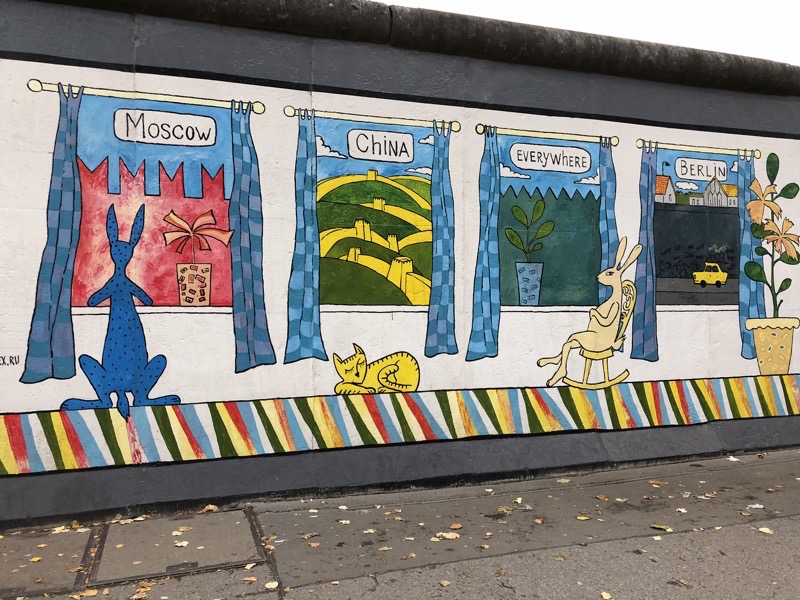


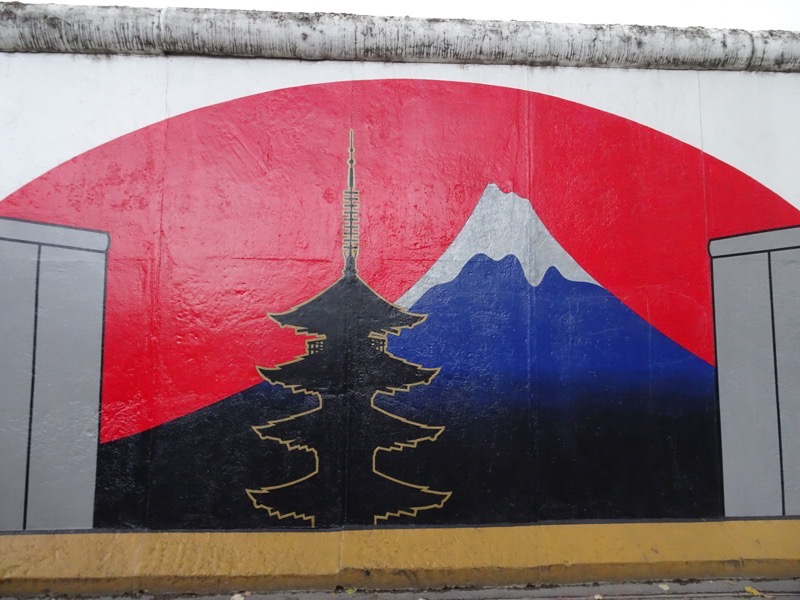 And it was about this time that our beautiful day with it’s 17C higher in temp then yesterday started to literally rain on our parade. So we hightailed it to the nearest train station and head back to the hotel.
And it was about this time that our beautiful day with it’s 17C higher in temp then yesterday started to literally rain on our parade. So we hightailed it to the nearest train station and head back to the hotel.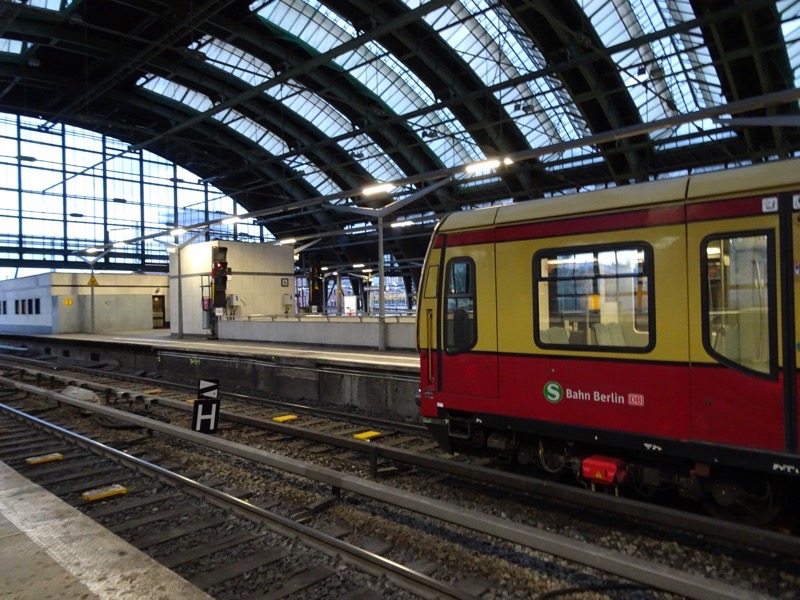
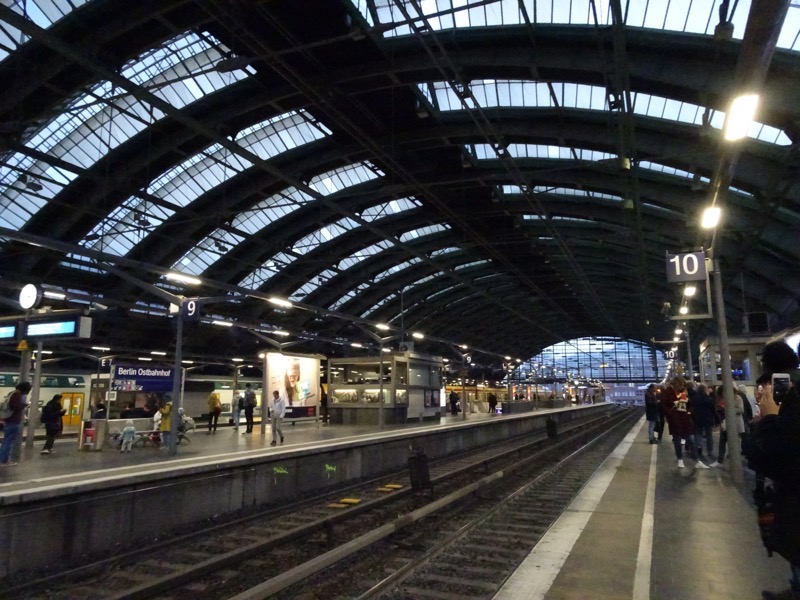
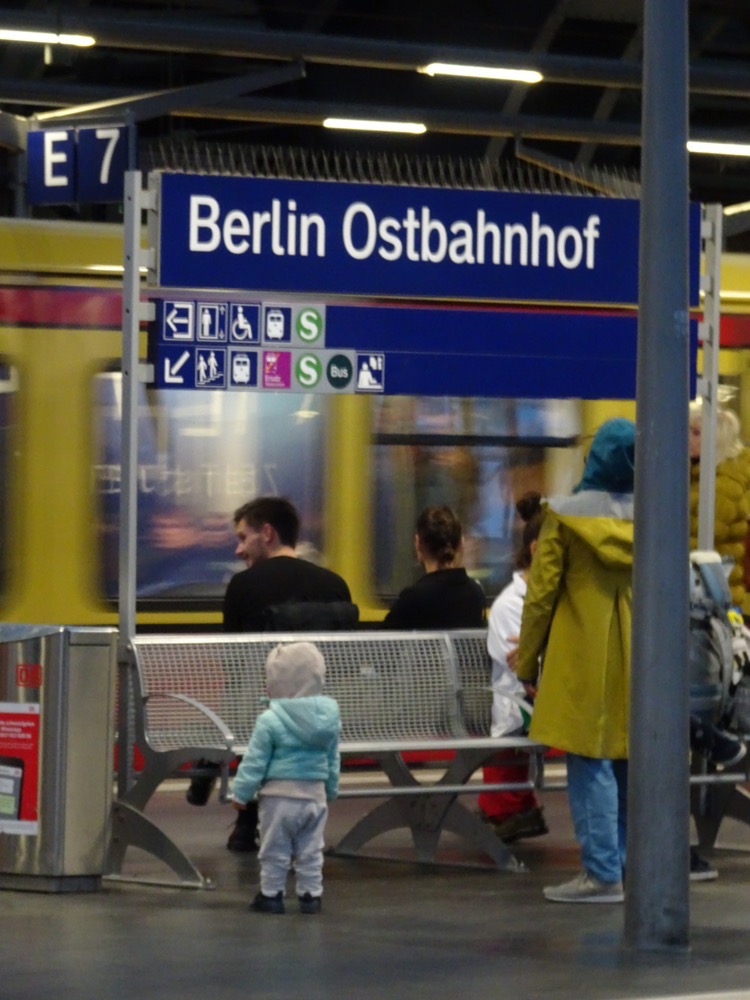 And so ends our last day in Europe… for tomorrow we fly from Berlin to London to Singapore to Brisbane and all things going to plan, we arrive two days from now.
And so ends our last day in Europe… for tomorrow we fly from Berlin to London to Singapore to Brisbane and all things going to plan, we arrive two days from now.
It’s been a blast!
